Introducing the Spanish Translation of the 'Phases of Team Development' -- 'Fases del Desarrollo del Equipo'
19 October 2021




Phases of Team Development
Teams (agile or otherwise) go through phases of development, and Dr. Bruce Tuckman established a popular and durable framework on the subject. According to Dr. Tuckman, all phases—Forming, Storming, Norming, Performing, and Adjourning—are necessary for teams to grow, tackle problems, find solutions, plan work, and deliver results.
Agile project management thought leader, influencer, and author Scott M. Graffius developed a related custom illustration, Phases of Team Development. It highlights the performance level, characteristics, and proven strategies for each of the phases. Project Managers, Scrum Masters, Agile Coaches, DevOps Leads, and other professionals can apply the information to help handle challenges or issues experienced by teams. By doing so, they’ll advance the teams' happiness and productivity, as well as the teams' (and their own) success. Graffius updates the content periodically.
He released a new version of the visual on January 4, 2021. A related article covers the update, bibliography, permission requests, and high-resolution downloadable files of the English version of the visual.
The Spanish version is covered next.

Permission Requests and Downloadable High-Resolution Files of 'Phases of Team Development' Illustration in Spanish

For permission requests, contact the email address noted in the image above.
High resolution images of the Fases del Desarrollo del Equipo (Formación, Turbulencia, Normalización, Desempeño, y Disolución) are available at the following links: here for the JPG file and here for the PNG file.
Citation for Spanish version: Graffius, Scott M. (2021). Fases del Desarrollo del Equipo. Digital Object Identifier (DOI): 10.13140/RG.2.2.28150.93765. DOI link: https://dx.doi.org/10.13140/RG.2.2.28150.93765.

Note: Some Spanish-language publications use different words for some of the phases. For example, 'Storming' is translated as 'Turbulencia' — but 'Conflicto' or other alternatives are occasionally used instead.* This article and the related Fases del Desarrollo del Equipo illustration incorporate the selections for phases referenced in the Spanish version of the Project Management Institute's A Guide to the Project Management Body of Knowledge. The five phases in Spanish are:
- Formación,
- Turbulencia,
- Normalización,
- Desempeño, y
- Disolución.



Post-Publication Notes
If there are any supplements or updates to this article after the date of publication, they will appear here.
After this article was published, Scott M. Graffius developed an updated version of his work on the Phases of Team Development (also referred to as Tuckman's Model of Team Dynamics, etc.). The newest (2024) edition is here. Note: It is in English. To date, there is not an update for the version in Spanish.


About Scott M. Graffius

Scott M. Graffius is an agile project management practitioner, consultant, award-winning author, and international speaker. He has generated over one billion dollars of business value in aggregate for the organizations he has served. Graffius is the founder, CEO, and principal consultant at Exceptional PPM and PMO Solutions™ and subsidiary Exceptional Agility™, based in Los Angeles, California. His expertise spans project, program, portfolio, and PMO leadership inclusive of agile, traditional, and hybrid approaches. Content from his books (Agile Scrum: Your Quick Start Guide with Step-by-Step Instructions and Agile Transformation: A Brief Story of How an Entertainment Company Developed New Capabilities and Unlocked Business Agility to Thrive in an Era of Rapid Change), workshops, speaking engagements, and more have been featured and used by businesses, governments, and universities including Gartner, Microsoft, Deloitte, Oracle, Cisco, Ford, Qantas, Atlassian, Bayer, the National Academy of Sciences, the United States Department of Energy, the United States Army, Project Management Institute, the IEEE, the New Zealand Ministry of Education, Tufts University, Texas A&M University, Virginia Tech, Penn State, Warsaw University of Technology, University of Waterloo, Loughborough University London, and others. Graffius has spoken at 55 conferences and other events around the world, including Armenia, Australia, Brazil, Canada, Czech Republic, Finland, France, Germany, Greece, India, Ireland, Lithuania, Luxembourg, Netherlands, New Zealand, Sweden, United Kingdom, and the United States. Thinkers360 named Graffius a global top thought leader and influencer in four domains: Agile, Change Management, Digital Transformation, and GovTech.
His full bio is available at https://AgileScrumGuide.com.
Connect with Scott on Twitter, Facebook, and LinkedIn.

About Agile Scrum: Your Quick Start Guide with Step-by-Step Instructions
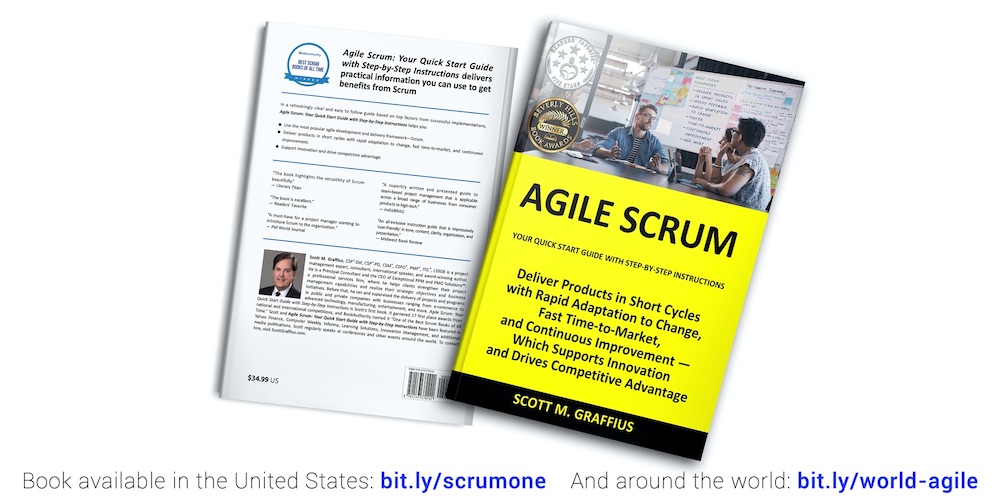
Shifting customer needs are common in today's marketplace. Businesses must be adaptive and responsive to change while delivering an exceptional customer experience to be competitive.
There are a variety of frameworks supporting the development of products and services, and most approaches fall into one of two broad categories: traditional or agile. Traditional practices such as waterfall engage sequential development, while agile involves iterative and incremental deliverables. Organizations are increasingly embracing agile to manage projects, and best meet their business needs of rapid response to change, fast delivery speed, and more.
With clear and easy to follow step-by-step instructions, Scott M. Graffius's award-winning Agile Scrum: Your Quick Start Guide with Step-by-Step Instructions helps the reader:
- Implement and use the most popular agile framework―Scrum;
- Deliver products in short cycles with rapid adaptation to change, fast time-to-market, and continuous improvement; and
- Support innovation and drive competitive advantage.
Hailed by Literary Titan as “the book highlights the versatility of Scrum beautifully.”
Winner of 17 first place awards.
Agile Scrum: Your Quick Start Guide with Step-by-Step Instructions is available in paperback and ebook/Kindle worldwide. Some links by country follow.
- 🇦🇺 Australia
- 🇦🇹 Austria
- 🇧🇪 Belgium
- 🇧🇷 Brazil
- 🇨🇦 Canada
- 🇨🇿 Czech Republic
- 🇩🇰 Denmark
- 🇫🇮 Finland
- 🇫🇷 France
- 🇩🇪 Germany
- 🇬🇷 Greece
- 🇭🇺 Hungary
- 🇮🇳 India
- 🇮🇪 Ireland
- 🇮🇱 Israel
- 🇮🇹 Italy
- 🇯🇵 Japan
- 🇱🇺 Luxembourg
- 🇲🇽 Mexico
- 🇳🇱 Netherlands
- 🇳🇿 New Zealand
- 🇳🇴 Norway
- 🇪🇸 Spain
- 🇸🇪 Sweden
- 🇨🇭 Switzerland
- 🇦🇪 UAE
- 🇬🇧 United Kingdom
- 🇺🇸 United States
- 🌏 More countries

About Agile Transformation: A Brief Story of How an Entertainment Company Developed New Capabilities and Unlocked Business Agility to Thrive in an Era of Rapid Change

Thriving in today's marketplace frequently depends on making a transformation to become more agile. Those successful in the transition enjoy faster delivery speed and ROI, higher satisfaction, continuous improvement, and additional benefits.
Based on actual events, Agile Transformation: A Brief Story of How an Entertainment Company Developed New Capabilities and Unlocked Business Agility to Thrive in an Era of Rapid Change provides a quick (60-90 minute) read about a successful agile transformation at a multinational entertainment and media company, told from the author's perspective as an agile coach.
The award-winning book by Scott M. Graffius is available in paperback and ebook/Kindle worldwide. Some links by country follow.
- 🇦🇺 Australia
- 🇦🇹 Austria
- 🇧🇷 Brazil
- 🇨🇦 Canada
- 🇨🇿 Czech Republic
- 🇩🇰 Denmark
- 🇫🇮 Finland
- 🇫🇷 France
- 🇩🇪 Germany
- 🇬🇷 Greece
- 🇮🇳 India
- 🇮🇪 Ireland
- 🇯🇵 Japan
- 🇱🇺 Luxembourg
- 🇲🇽 Mexico
- 🇳🇱 Netherlands
- 🇳🇿 New Zealand
- 🇪🇸 Spain
- 🇸🇪 Sweden
- 🇨🇭 Switzerland
- 🇦🇪 United Arab Emirates
- 🇬🇧 United Kingdom
- 🇺🇸 United States
- 🌏 More countries

Let's Connect

Connect with AgileScrumGuide.com on Facebook, Twitter, LinkedIn, Instagram, and Pinterest.
And connect with agile project management practitioner, consultant, award-winning author, and international speaker Scott M. Graffius on Twitter, Facebook, and LinkedIn.

* As covered above, the five phases in Spanish are: Formación, Turbulencia, Normalización, Desempeño, y Disolución. Alternatives occasionally used by others follow—in italics:
- Formación (some alternatives used by others include: Constitución, Formando, and Estableciendo)
- Turbulencia (some alternatives used by others include: Conflicto, Confrontación, Enfrentamiento, Asalt, and Asalto)
- Normalización (some alternatives used by others include: Normativa, Normativo, Normación, Normas, and Normar)
- Desempeño (some alternatives used by others include: Ejecución, Rendimiento, Actuación, and Actuar)
- Disolución (some alternatives used by others include: Clausura, Aplazamiento, Finalización, Terminación, and Suspender)

© Copyright 2021 Scott M. Graffius, AgileScrumGuide.com. All rights reserved. This material may not be published, broadcast, rewritten or redistributed without the express written permission of Scott M. Graffius/AgileScrumGuide.com.

Agile Has a Long and Colorful Heritage: An Infographic Timeline
19 February 2018
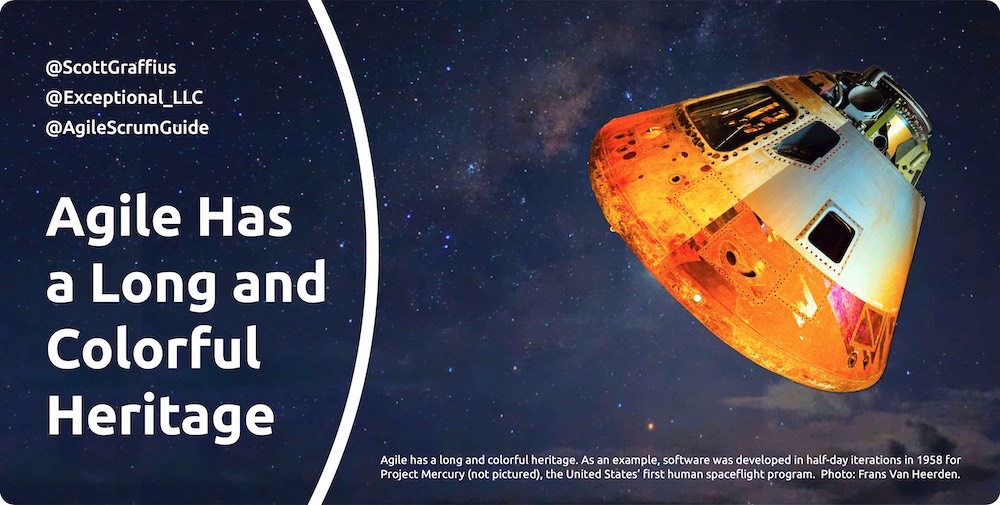

Agile Workflows

There's a widely-held view that agile development is new. But agile was used decades before it became well-known. For example, software was developed in half-day iterations in 1958 for Project Mercury, the United States' first human spaceflight program. And Harlan Mills of IBM promoted in 1968 that "software development should be done incrementally, in stages with continuous user participation and replanning."
Many innovators and visionaries have advanced agile—which includes Scrum—principles and practices over time. Agile Has a Long and Colorful Heritage: A Timeline Infographic from Exceptional PPM and PMO Solutions™ illustrates via specific examples how agile has progressively evolved. The downloadable infographic is located here.

About Agile Scrum: Your Quick Start Guide with Step-by-Step Instructions
A fantastic agile transformation experience and result with a client organization in the entertainment industry was the inspiration for Scott M. Graffius’ book, Agile Scrum: Your Quick Start Guide with Step-by-Step Instructions. The publication helps technical and non-technical teams develop and deliver products in short cycles with rapid adaptation to change, fast time-to-market, continuous improvement, and more. It has garnered several first place awards. A trailer, high-resolution images, reviews, and a detailed list of awards are in the digital media kit. Agile Scrum: Your Quick Start Guide with Step-by-Step Instructions is offered in digital and print formats.
The ebook (ASIN: B01FZ0JIIY) is available in:
- Australia,
- Brazil,
- Canada,
- France,
- Germany,
- India,
- Italy,
- Japan,
- Mexico,
- the Netherlands,
- Spain,
- the United Kingdom, and
- the United States.
The paperback (ISBN-13: 9781533370242) is for sale at:
- Amazon,
- Barnes & Noble,
- Strand Books,
- Harvard Book Store,
- Books-a-Million,
- The Booksmith,
- Hudson Booksellers,
- Savoy Bookshop & Café,
- Compass Books at SFO/Books Inc.,
- Books & Books - Miami,
- University Press Books - Berkeley,
- and other retailers and partners in the United States and around the world.

Let's Connect

Connect with AgileScrumGuide.com on Facebook, Twitter, LinkedIn, Instagram, and Pinterest.
And connect with agile project management practitioner, consultant, award-winning author, and international speaker Scott M. Graffius on Twitter, Facebook, and LinkedIn.

© Copyright 2018 Scott M. Graffius, AgileScrumGuide.com. All rights reserved. This material may not be published, broadcast, rewritten or redistributed without the express written permission of Scott M. Graffius/AgileScrumGuide.com.

Use Tuckman's Model of Team Dynamics (Forming, Storming, Norming, Performing, and Adjourning) to Help Your Teams Grow and Advance with Speed and Agility
04 January 2021
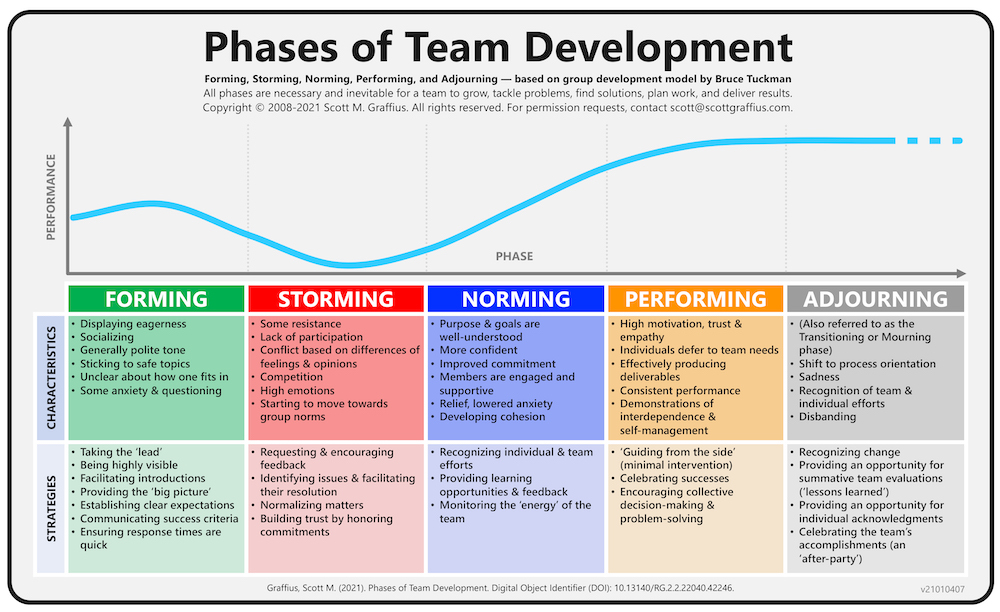

If there are any supplements or updates to this article after the date of publication, they will appear in the Post-Publication Notes section at the end of this article.

2021 Update
Teams (agile or otherwise) go through phases of development, and Dr. Bruce Tuckman established a popular and durable framework on the subject. According to Dr. Tuckman, all phases—Forming, Storming, Norming, Performing, and Adjourning—are necessary for teams to grow, tackle problems, find solutions, plan work, and deliver results.
Agile project management thought leader, influencer, and author Scott M. Graffius developed a related custom illustration, Phases of Team Development. It highlights the performance level, characteristics, and proven strategies for each of the phases. Project Managers, Scrum Masters, Agile Coaches, DevOps Leads, and other professional can apply the information to help handle challenges or issues experienced by teams. By doing so, they’ll advance the teams' happiness and productivity, as well as the teams' (and their own) success. Graffius refreshes the content periodically.
He released an updated version of the visual on January 4, 2021. This article features the new version of the Phases of Team Development illustration along with an overview of the characteristics and key strategies for each phase. The new image is shown below. Read on for details including information on permission requests and downloadable high-resolution versions of the visual.

Five Phases of Team Development
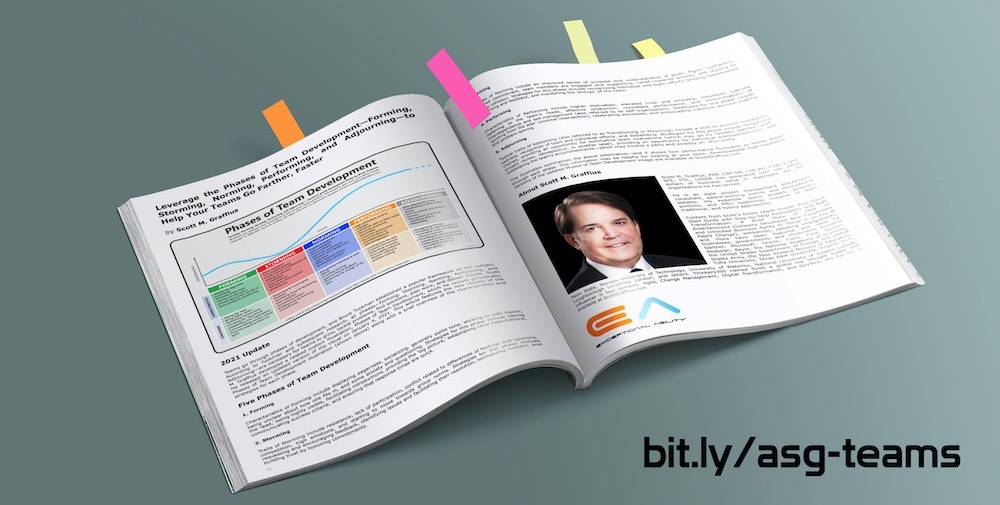
1. Forming
Characteristics of Forming include displaying eagerness, socializing, generally polite tone, sticking to safe topics, being unclear about how one fits in, and some anxiety and questioning.
Strategies for this phase include taking the ‘lead,’ being highly visible, facilitating introductions, providing the ‘big picture,’ establishing clear expectations, communicating success criteria, and ensuring that response times are quick.
2. Storming
Traits of Storming include resistance, lack of participation, conflict related to differences of feelings and opinions, competition, high emotions, and starting to move towards group norms.
Strategies for this phase include requesting and encouraging feedback, identifying issues and facilitating their resolution, normalizing matters, and building trust by honoring commitments.
3. Norming
Features of Norming include an improved sense of purpose and understanding of goals, higher confidence, improved commitment, team members are engaged and supportive, relief—lowered anxiety, and starting to develop cohesion.
Strategies for this phase include recognizing individual and team efforts, proving opportunities for learning and feedback, and monitoring the ‘energy’ of the team.
4. Performing
Characteristics of Performing include higher motivation, elevated trust and empathy, individuals typically deferring to the team's needs, effective production, consistent performance, and demonstrations of interdependence and self-management (also referred to as self-organization).
Strategies for this phase include ‘guiding from the side’ (minimal intervention), celebrating successes, and encouraging collective decision-making and problem-solving.
5. Adjourning
Typical traits of Adjourning (also referred to as Transitioning or Mourning) include a shift to process orientation, sadness, recognition of team and individual efforts, and disbanding.
Strategies for this phase include recognizing change, providing an opportunity for summative team evaluations (which may go by ‘lessons learned,’ post-project review, retrospective, or another label), providing an opportunity for individual acknowledgments, and celebrating the team's accomplishments—which may involve a party and possibly an after-party.

As shown, performance fluctuates as teams move through the phases. Review the characteristics to help identify the team's current phase, then apply the corresponding proven strategies to help them advance.

Bibliography
Select list of publications
- Alford, J. (2019, April 11). Our Co-Production Journey: From Sandpits to Bird Boxes. London, United Kingdom: Imperial College London.
- Bennett, M., Gadlin, H., & Marchand, C. (2018). Collaboration Team Science: Field Guide. Rockville, MD: National Institutes of Health.
- Couture, N. (2016, October 27). A Note About Teams. CIO. Boston, MA: International Data Group (IDG).
- Daly, L. (2002). Identify Your Project Management Team’s Level of Development and Facilitate It to Success. Paper presented at Project Management Institute Annual Seminars and Symposium, San Antonio, TX. Newtown Square, PA: Project Management Institute.
- Deloitte (2017). Digital Era Technology Operating Models, Volume 2. New York, NY: Deloitte Touche Tohmatsu Limited.
- Finkelstein, S. (2017, October 29). Why Companies Should Hire Teams, Not Individuals. The Wall Street Journal. New York, NY: The Wall Street Journal.
- Forbes (2018, April 23). How to Fast-Track Any Team to Success. Forbes. New York, NY: Forbes.
- Forbes (2012, October 27). How the iPad Mini is Defining Tim Cook’s Apple. Forbes. New York, NY: Forbes.
- Glover, P. (2012, March 13). Team Conflict: Why It’s a Good Thing. Fast Company. New York, NY: Mansueto Ventures.
- Graffius, Scott M. (2021). Phases of Team Development. Los Angeles, CA: Scott M. Graffius. Digital Object Identifier (DOI): 10.13140/RG.2.2.22040.42246.
- Jovanovic, M., Mesquida, A., Radaković, N., & Mas, A. (2016). Agile Retrospective Games for Different Team Development Phases. Journal of Universal Computer Science, 22: 1489-1508.
- Kane, G. C. (2014, October 7). Why Your Company is Probably Measuring Social Media Wrong. MIT Sloan Management Review. Cambridge, MA: MIT Sloan Management Review.
- KPMG (2017). The Digital Fund, Season 2. Amstelveen, Netherlands: KPMG International.
- Madden, D. (2019, May 19). The Four Stages of Building a Great Team – and the One Where Things Usually Go Wrong. Inc. Magazine. New York, NY: Inc. Magazine.
- Makar, A. (2011, July 13). Lessons Learned in Norming and Performing Team Development Phases. Louisville, KY: TechRepublic.
- Martinuzzi, B. (2012, June 8). Six Tips Guaranteed to Reduce Workplace Frustrations. New York, NY: American Express Company.
- Microsoft (2019, June 15). Is the Latest Technology the Key to Your Team’s Success, or is There Something Else? Microsoft Developer Support. Accessed at: https://devblogs.microsoft.com/premier-developer/is-the-latest-technology-the-key-to-your-teams-success-or-is-there-something-else. Redmond, WA: Microsoft.
- Mocko, G., & Linnerud, B. (2016). Measuring the Effects of Goal Alignment on Innovative Engineering Design Projects. International Journal of Engineering Education, 32: 55-63.
- Romanelli, M. (2019, September 11). Teamwork Accelerated. PM Times. Newmarket, Ontario, Canada: Macgregor Communications.
- Riggs, A. (2020, October 15). Why I Start All My Video Meetings with Collaborative Games (Spoiler: It’s Not Boredom). Amsterdam, the Netherlands: The Next Web (TNW).
- Rowley, D., & Lange, M. (2007). Forming to Performing: The Evolution of an Agile Team. IEEE Computer Society Proceedings. Agile 2007, 1: 408-414.
- Scrum Alliance (2020). Learning Objectives Examples. Denver, CO: Scrum Alliance.
- Sakpal, M. (2020, March 3. Learn How to Debunk These Five Restructuring Myths. Stamford, CT: Gartner, Inc.
- Stern, S. (2018, September 26). Is Your Team Working the Rory Underwood Way? Financial Times. London, United Kingdom: The Financial Times, a Nikkei Company.
- Telford, R. (2013, June 4). This is Where It Gets Interesting. Armonk, NY: International Business Machines (IBM) Corporation.
- Tuckman, B. W. (1965). Developmental Sequence in Small Groups. Psychological Bulletin, 63: 384-399.
- Tuckman, B. W., & Jensen, M. A. C. (1977). Stages of Small-Group Development Revisited. Group and Organizational Studies, 2 (4): 419-427.
- United States Army (2015). Innovative Learning: A Key to National Security. Washington, DC: United States Army.
- Watkins, M. D. (2016, June). Leading the Team You Inherit. Harvard Business Review. Brighton, MA: Harvard Business Publishing.
- World Health Organization (2012). Being an Effective Team Player. Accessed at: https://www.who.int/patientsafety/education/curriculum/course4_handout.pdf. Geneva, Switzerland: World Health Organization.

About Scott M. Graffius

Scott M. Graffius, PMP, CSP-SM, CSP-PO, CSM, CSPO, SFE, ITIL, LSSGB has generated hundreds of millions of dollars of business value in aggregate for the organizations he has served. He is an agile project management practitioner, consultant, award-winning author, and international speaker. His expertise spans project, program, portfolio, and PMO leadership inclusive of agile, traditional, and hybrid approaches. Content from Scott's books (Agile Scrum: Your Quick Start Guide with Step-by-Step Instructions and Agile Transformation: A Brief Story of How an Entertainment Company Developed New Capabilities and Unlocked Business Agility to Thrive in an Era of Rapid Change), workshops, speaking engagements, and more have been featured and used by businesses, governments, and universities including Gartner, Microsoft, Oracle, Cisco, Ford, Qantas, Atlassian, Bayer, the National Academy of Sciences, the United States Department of Energy, the United States Army, the New Zealand Ministry of Education, Tufts University, Texas A&M University, Virginia Tech, Penn State, Warsaw University of Technology, University of Waterloo, Loughborough University London, and others. Thinkers360 named Scott a global top thought leader and influencer in three domains: Agile, Digital Transformation, and GovTech. His full bio is available at https://www.scottgraffius.com/bio.html.

About Agile Scrum: Your Quick Start Guide with Step-by-Step Instructions

Shifting customer needs are common in today's marketplace. Businesses must be adaptive and responsive to change while delivering an exceptional customer experience to be competitive.
There are a variety of frameworks supporting the development of products and services, and most approaches fall into one of two broad categories: traditional or agile. Traditional practices such as waterfall engage sequential development, while agile involves iterative and incremental deliverables. Organizations are increasingly embracing agile to manage projects, and best meet their business needs of rapid response to change, fast delivery speed, and more.
With clear and easy to follow step-by-step instructions, Scott M. Graffius's award-winning Agile Scrum: Your Quick Start Guide with Step-by-Step Instructions helps the reader:
- Implement and use the most popular agile framework―Scrum;
- Deliver products in short cycles with rapid adaptation to change, fast time-to-market, and continuous improvement; and
- Support innovation and drive competitive advantage.
Hailed by Literary Titan as “the book highlights the versatility of Scrum beautifully.”
Winner of 17 first place awards.
Agile Scrum: Your Quick Start Guide with Step-by-Step Instructions is available in paperback and ebook/Kindle worldwide. Some links by country follow.
- 🇦🇺 Australia
- 🇦🇹 Austria
- 🇧🇪 Belgium
- 🇧🇷 Brazil
- 🇨🇦 Canada
- 🇨🇿 Czech Republic
- 🇩🇰 Denmark
- 🇫🇮 Finland
- 🇫🇷 France
- 🇩🇪 Germany
- 🇬🇷 Greece
- 🇭🇺 Hungary
- 🇮🇳 India
- 🇮🇪 Ireland
- 🇮🇱 Israel
- 🇮🇹 Italy
- 🇯🇵 Japan
- 🇱🇺 Luxembourg
- 🇲🇽 Mexico
- 🇳🇱 Netherlands
- 🇳🇿 New Zealand
- 🇳🇴 Norway
- 🇪🇸 Spain
- 🇸🇪 Sweden
- 🇨🇭 Switzerland
- 🇦🇪 UAE
- 🇬🇧 United Kingdom
- 🇺🇸 United States
- 🌏 More countries

About Agile Transformation: A Brief Story of How an Entertainment Company Developed New Capabilities and Unlocked Business Agility to Thrive in an Era of Rapid Change

Thriving in today's marketplace frequently depends on making a transformation to become more agile. Those successful in the transition enjoy faster delivery speed and ROI, higher satisfaction, continuous improvement, and additional benefits.
Based on actual events, Agile Transformation: A Brief Story of How an Entertainment Company Developed New Capabilities and Unlocked Business Agility to Thrive in an Era of Rapid Change provides a quick (60-90 minute) read about a successful agile transformation at a multinational entertainment and media company, told from the author's perspective as an agile coach.
The award-winning book by Scott M. Graffius is available in paperback and ebook/Kindle worldwide. Some links by country follow.
- 🇦🇺 Australia
- 🇦🇹 Austria
- 🇧🇷 Brazil
- 🇨🇦 Canada
- 🇨🇿 Czech Republic
- 🇩🇰 Denmark
- 🇫🇮 Finland
- 🇫🇷 France
- 🇩🇪 Germany
- 🇬🇷 Greece
- 🇮🇳 India
- 🇮🇪 Ireland
- 🇯🇵 Japan
- 🇱🇺 Luxembourg
- 🇲🇽 Mexico
- 🇳🇱 Netherlands
- 🇳🇿 New Zealand
- 🇪🇸 Spain
- 🇸🇪 Sweden
- 🇨🇭 Switzerland
- 🇦🇪 United Arab Emirates
- 🇬🇧 United Kingdom
- 🇺🇸 United States
- 🌏 More countries

Let's Connect

Connect with AgileScrumGuide.com on Facebook, Twitter, LinkedIn, Instagram, and Pinterest.
And connect with agile project management practitioner, consultant, award-winning author, and international speaker Scott M. Graffius on Twitter, Facebook, and LinkedIn.


Post-Publication Notes
Update on 10 January 2025
Scott M. Graffius periodically updates his 'Phases of Team Development' work. The most current edition is here.

© Copyright 2021 Scott M. Graffius, AgileScrumGuide.com. All rights reserved. This material may not be published, broadcast, rewritten or redistributed without the express written permission of Scott M. Graffius/AgileScrumGuide.com.

Use Tuckman's Model of Team Dynamics (Forming, Storming, Norming, Performing, and Adjourning) to Help Your Teams Succeed
14 February 2022


If there are any supplements or updates to this article after the date of publication, they will appear in the Post-Publication Notes section at the end of this article.

2022 Update
Want happier and more productive teams? Among other things, it takes great leadership. And proven strategies can provide a real edge! That’s where the groundbreaking work by Bruce W. Tuckman — Ph.D. in Psychology from Princeton — comes in.
Tuckman conducted extensive research on group dynamics, and he published a related model in 1965. At that time, the model included four phases: forming, storming, norming, and performing. However, Dr. Tuckman subsequently determined that adjourning was so important that he, with Mary Ann Jensen, updated his model in 1977 to add adjourning as the fifth phase. According to Tuckman, all five phases — Forming, Storming, Norming, Performing, and Adjourning — are necessary for teams to grow, tackle problems, find solutions, plan work, and deliver results.
Tuckman’s model has stood the test of time because it remains highly relevant and beneficial. Since his work was published, it has been supported by additional peer-reviewed research. And it has received recommendations and coverage from leading organizations including Google, Harvard Business Review, IEEE, MIT, Fast Company, NASA, Microsoft, TNW, Project Management Institute, Scrum Alliance, Scrum.org, Gartner, CIO, RAND Corporation, Software Engineering Institute, University of Edinburgh, Cisco, KPMG, Warsaw University of Technology, Software Engineering Institute, DevOps Institute, American Express, SANS Institute, Zurich University, SAP, ViacomCBS, Oxford University, American Management Association, AT&T, University of Southern California, IBM, and many others.
Agile project management practitioner, consultant, award-winning author, international speaker, thought leader, and influencer Scott M. Graffius developed a related custom illustration, Phases of Team Development. It highlights the performance level, characteristics, and proven strategies for each of the five phases. Project Managers, Scrum Masters, Agile Coaches, DevOps Leads, and other professionals can apply the information to help handle challenges or issues experienced by teams. By doing so, they’ll advance the teams' happiness and productivity, as well as the teams' success.
Graffius updates the content periodically. He released an updated version of the visual on February 14, 2022. This article features the newest version of the Phases of Team Development illustration. Read on for details including information on permission requests and downloadable high-resolution versions of the image.

Five Phases of Team Development
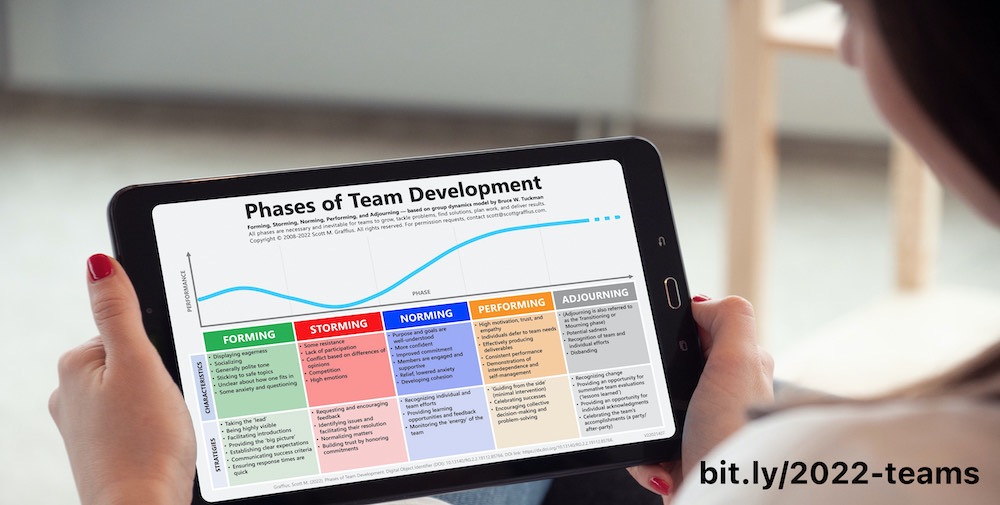
1. Forming
Characteristics of Forming include displaying eagerness, socializing, generally polite tone, sticking to safe topics, unclear about how one fits in, and some anxiety and questioning.
Strategies for this phase include taking the ‘lead,’ being highly visible, facilitating introductions, providing the ‘big picture,’ establishing clear expectations, communicating success criteria, and ensuring response times are quick.
2. Storming
Traits of Storming include some resistance, lack of participation, conflict based on differences of opinions, competition, and high emotions.
Strategies for this phase include requesting and encouraging feedback, identifying issues and facilitating their resolution, normalizing matters, and building trust by honoring commitments.
3. Norming
Features of Norming include purpose and goals are well-understood, more confident, improved commitment, members are engaged and supportive, relief (lowered anxiety), and developing cohesion.
Strategies for this phase include recognizing individual and team efforts, providing learning opportunities and feedback, and monitoring the ‘energy’ of the team.
4. Performing
Characteristics of Performing include high motivation, trust, and empathy; individuals defer to team needs; effectively producing deliverables; consistent performance; and demonstrations of interdependence and self-management.
Strategies for this phase include ‘guiding from the side’ (minimal intervention), celebrating successes, and encouraging collective decision-making and problem-solving.
5. Adjourning
Typical traits of Adjourning (also referred to as Transitioning or Mourning) include potential sadness, recognition of team and individual efforts, and disbanding.
Strategies for this phase include recognizing change, providing an opportunity for summative team evaluations ('lessons learned'), providing an opportunity for individual acknowledgments, and celebrating the team’s accomplishments — which may involve a party and possibly an after-party.

As shown, performance fluctuates as teams move through the phases. Review the characteristics to help identify the team's current phase, then apply the corresponding proven strategies to help them advance.

Permission Requests and Downloadable High-Resolution Versions of 'Phases of Team Development' Illustration

For permission requests, contact Scott M. Graffius at the email address noted in the image above.

Bibliography
Select list of publications
- Alford, J. (2019, April 11). Our Co-Production Journey: From Sandpits to Bird Boxes. London, United Kingdom: Imperial College London.
- Bennett, M., Gadlin, H., & Marchand, C. (2018). Collaboration Team Science: Field Guide. Rockville, MD: National Institutes of Health.
- Couture, N. (2016, October 27). A Note About Teams. CIO. Boston, MA: International Data Group (IDG).
- Daly, L. (2002). Identify Your Project Management Team’s Level of Development and Facilitate It to Success. Paper presented at Project Management Institute Annual Seminars and Symposium, San Antonio, TX. Newtown Square, PA: Project Management Institute.
- Deloitte (2017). Digital Era Technology Operating Models, Volume 2. New York, NY: Deloitte Touche Tohmatsu Limited.
- Finkelstein, S. (2017, October 29). Why Companies Should Hire Teams, Not Individuals. The Wall Street Journal. New York, NY: The Wall Street Journal.
- Forbes (2018, April 23). How to Fast-Track Any Team to Success. Forbes. New York, NY: Forbes.
- Forbes (2012, October 27). How the iPad Mini is Defining Tim Cook’s Apple. Forbes. New York, NY: Forbes.
- Glover, P. (2012, March 13). Team Conflict: Why It’s a Good Thing. Fast Company. New York, NY: Mansueto Ventures.
- Graffius, Scott M. (2021). Phases of Team Development. Los Angeles, CA: Scott M. Graffius. Digital Object Identifier (DOI): 10.13140/RG.2.2.22040.42246.
- Jovanovic, M., Mesquida, A., Radaković, N., & Mas, A. (2016). Agile Retrospective Games for Different Team Development Phases. Journal of Universal Computer Science, 22: 1489-1508.
- Kane, G. C. (2014, October 7). Why Your Company is Probably Measuring Social Media Wrong. MIT Sloan Management Review. Cambridge, MA: MIT Sloan Management Review.
- KPMG (2017). The Digital Fund, Season 2. Amstelveen, Netherlands: KPMG International.
- Madden, D. (2019, May 19). The Four Stages of Building a Great Team – and the One Where Things Usually Go Wrong. Inc. Magazine. New York, NY: Inc. Magazine.
- Makar, A. (2011, July 13). Lessons Learned in Norming and Performing Team Development Phases. Louisville, KY: TechRepublic.
- Martinuzzi, B. (2012, June 8). Six Tips Guaranteed to Reduce Workplace Frustrations. New York, NY: American Express Company.
- Microsoft (2019, June 15). Is the Latest Technology the Key to Your Team’s Success, or is There Something Else? Microsoft Developer Support. Accessed at: https://devblogs.microsoft.com/premier-developer/is-the-latest-technology-the-key-to-your-teams-success-or-is-there-something-else. Redmond, WA: Microsoft.
- Mocko, G., & Linnerud, B. (2016). Measuring the Effects of Goal Alignment on Innovative Engineering Design Projects. International Journal of Engineering Education, 32: 55-63.
- Romanelli, M. (2019, September 11). Teamwork Accelerated. PM Times. Newmarket, Ontario, Canada: Macgregor Communications.
- Riggs, A. (2020, October 15). Why I Start All My Video Meetings with Collaborative Games (Spoiler: It’s Not Boredom). Amsterdam, the Netherlands: The Next Web (TNW).
- Rowley, D., & Lange, M. (2007). Forming to Performing: The Evolution of an Agile Team. IEEE Computer Society Proceedings. Agile 2007, 1: 408-414.
- Scrum Alliance (2020). Learning Objectives Examples. Denver, CO: Scrum Alliance.
- Sakpal, M. (2020, March 3. Learn How to Debunk These Five Restructuring Myths. Stamford, CT: Gartner, Inc.
- Stern, S. (2018, September 26). Is Your Team Working the Rory Underwood Way? Financial Times. London, United Kingdom: The Financial Times, a Nikkei Company.
- Telford, R. (2013, June 4). This is Where It Gets Interesting. Armonk, NY: International Business Machines (IBM) Corporation.
- Tuckman, B. W. (1965). Developmental Sequence in Small Groups. Psychological Bulletin, 63: 384-399.
- Tuckman, B. W., & Jensen, M. A. C. (1977). Stages of Small-Group Development Revisited. Group and Organizational Studies, 2 (4): 419-427.
- United States Army (2015). Innovative Learning: A Key to National Security. Washington, DC: United States Army.

About Scott M. Graffius

Scott M. Graffius, PMP, CSP-SM, CSP-PO, CSM, CSPO, SFE, ITIL, LSSGB is an agile project management practitioner, consultant, multi award-winning author, and international speaker. He has generated over $1.75 billion of business value in aggregate for the organizations he has served. Graffius is the founder, CEO, and principal consultant at Exceptional PPM and PMO Solutions™ and subsidiary Exceptional Agility™. His expertise spans project, program, portfolio, and PMO leadership inclusive of agile, traditional, and hybrid approaches. Content from his books (Agile Scrum: Your Quick Start Guide with Step-by-Step Instructions and Agile Transformation: A Brief Story of How an Entertainment Company Developed New Capabilities and Unlocked Business Agility to Thrive in an Era of Rapid Change), workshops, speaking engagements, and more have been featured and used by businesses, professional associations, governments, and universities including Microsoft, Oracle, Cisco, Gartner, Deloitte, Project Management Institute, IEEE, SANS Institute, U.S. Soccer Federation, English Institute of Sport, Ford, Qantas, Atlassian, Wrike, Bayer, National Academy of Sciences, United States Department of Energy, United States Army, New Zealand Ministry of Education, Amsterdam Public Health Research Institute, Tufts University, Texas A&M University, Warsaw University of Technology, University of Waterloo, National University of Ireland Galway, Zurich University of Applied Sciences, and others. Graffius has spoken at 59 conferences and other events around the world, including Armenia, Australia, Brazil, Canada, Czech Republic, Finland, France, Germany, Greece, Hungary, India, Ireland, Lithuania, Luxembourg, Netherlands, New Zealand, Sweden, United Arab Emirates, United Kingdom, and the United States. Thinkers360 named Graffius a global top thought leader and influencer in four domains: Agile, Change Management, Digital Transformation, and GovTech. 


Post-Publication Notes
Update on 10 January 2025
Scott M. Graffius periodically updates his 'Phases of Team Development' work. The most current edition is here.

© Copyright 2022 Scott M. Graffius, AgileScrumGuide.com. All rights reserved. This material may not be published, broadcast, rewritten or redistributed without the express written permission of Scott M. Graffius/AgileScrumGuide.com.

Leverage the Phases of Team Development (Forming, Storming, Norming, Performing, and Adjourning) to Help Your Teams Succeed
10 January 2023
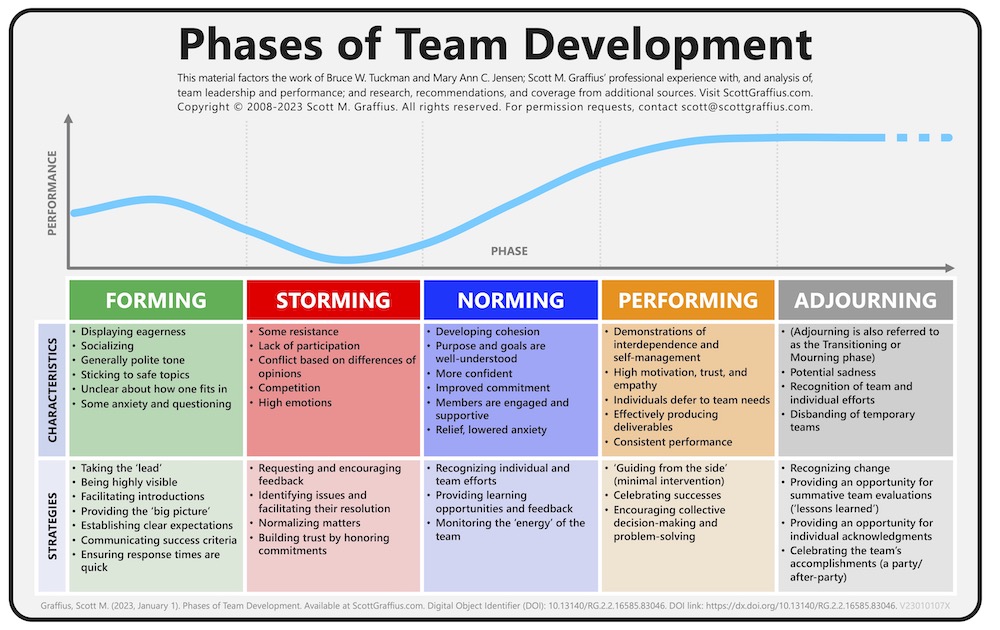

If there are any supplements or updates to this article after the date of publication, they will appear in the Post-Publication Notes section at the end of this article.

2023 Update
Want happier and more productive teams? Among other things, it takes great leadership. And proven strategies can provide you with a real advantage! That’s where the work by Bruce W. Tuckman — Ph.D. in Psychology from Princeton — and others comes in.
Tuckman conducted extensive research on team dynamics, and he published a related framework in 1965. At that time, the model included four phases: forming, storming, norming, and performing. However, Dr. Tuckman subsequently determined that adjourning was so important that he, with Mary Ann C. Jensen, updated his model in 1977 to add adjourning as the fifth phase. According to Tuckman, all five phases — Forming, Storming, Norming, Performing, and Adjourning — are necessary for teams to grow, tackle problems, find solutions, plan work, and deliver results.
In 2008, Scott M. Graffius started developing material on advancing teams’ happiness, productivity, and success. His respective Phases of Team Development content factors the work of Dr. Bruce W. Tuckman and Mary Ann C. Jensen; Graffius's experience with, and analysis of, team leadership and performance; and research, recommendations, and coverage from additional sources (examples are listed below).
The Phases of Team Development highlights the performance level, characteristics, and proven strategies for each of the five phases: Forming, Storming, Norming, Performing, and Adjourning. Project Managers, Scrum Masters, Agile Coaches, DevOps Leads, and other leaders can apply the information to help handle challenges or issues experienced by teams. By doing so, they’ll advance the teams' (and their own) happiness, productivity, and success.
Graffius updates the content periodically. This article features the newest (2023) version of the Phases of Team Development material. Read on for details including information on permission requests and downloadable high-resolution versions of the image.

Five Phases of Team Development
1. Forming
Characteristics of Forming include displaying eagerness, socializing, generally polite tone, sticking to safe topics, unclear about how one fits in, and some anxiety and questioning.
Strategies for this phase include taking the ‘lead,’ being highly visible, facilitating introductions, providing the ‘big picture,’ establishing clear expectations, communicating success criteria, and ensuring response times are quick.
2. Storming
Traits of Storming include some resistance, lack of participation, conflict based on differences of opinions, competition, and high emotions.
Strategies for this phase include requesting and encouraging feedback, identifying issues and facilitating their resolution, normalizing matters, and building trust by honoring commitments.
3. Norming
Features of Norming include purpose and goals are well-understood, more confident, improved commitment, members are engaged and supportive, relief (lowered anxiety), and developing cohesion.
Strategies for this phase include recognizing individual and team efforts, providing learning opportunities and feedback, and monitoring the ‘energy’ of the team.
4. Performing
Characteristics of Performing include high motivation, trust, and empathy; individuals defer to team needs; effectively producing deliverables; consistent performance; and demonstrations of interdependence and self-management.
Strategies for this phase include ‘guiding from the side’ (minimal intervention), celebrating successes, and encouraging collective decision-making and problem-solving.
5. Adjourning
Typical traits of Adjourning (also referred to as Transitioning or Mourning) include potential sadness, recognition of team and individual efforts, and disbanding.
Strategies for this phase include recognizing change, providing an opportunity for summative team evaluations ('lessons learned'), providing an opportunity for individual acknowledgments, and celebrating the team’s accomplishments — which may involve a party and possibly an after-party.

As shown, performance fluctuates as teams move through the phases. Review the characteristics to help identify the team's current phase, then apply the corresponding proven strategies to help them advance.


Select (partial) sources:
The Phases of Team Development by Scott M. Graffius factors the work of Dr. Bruce W. Tuckman and Mary Ann C. Jensen; Graffius's experience, observation, and analysis; and research, recommendations, and coverage from additional sources such as Google, Harvard Business Review, IEEE, MIT, Fast Company, NASA, Microsoft, TNW, Project Management Institute, Scrum Alliance, Scrum.org, Gartner, CIO, RAND Corporation, Software Engineering Institute, University of Edinburgh, Cisco, KPMG, Warsaw University of Technology, Software Engineering Institute, DevOps Institute, American Express, SANS Institute, Zurich University, SAP, ViacomCBS, Oxford University, American Management Association, AT&T, University of Southern California, IBM, and many others.
Select (partial) bibliography:
- Alford, J. (2019, April 11). Our Co-Production Journey: From Sandpits to Bird Boxes. London, United Kingdom: Imperial College London.
- Bennett, M., Gadlin, H., & Marchand, C. (2018). Collaboration Team Science: Field Guide. Rockville, MD: National Institutes of Health.
- Couture, N. (2016, October 27). A Note About Teams. CIO. Boston, MA: International Data Group (IDG).
- Daly, L. (2002). Identify Your Project Management Team’s Level of Development and Facilitate It to Success. Paper presented at Project Management Institute Annual Seminars and Symposium, San Antonio, TX. Newtown Square, PA: Project Management Institute.
- Deloitte (2017). Digital Era Technology Operating Models, Volume 2. New York, NY: Deloitte Touche Tohmatsu Limited.
- Finkelstein, S. (2017, October 29). Why Companies Should Hire Teams, Not Individuals. The Wall Street Journal. New York, NY: The Wall Street Journal.
- Forbes (2018, April 23). How to Fast-Track Any Team to Success. Forbes. New York, NY: Forbes.
- Forbes (2012, October 27). How the iPad Mini is Defining Tim Cook’s Apple. Forbes. New York, NY: Forbes.
- Glover, P. (2012, March 13). Team Conflict: Why It’s a Good Thing. Fast Company. New York, NY: Mansueto Ventures.
- Graffius, Scott M. (2021). Phases of Team Development. Los Angeles, CA: Scott M. Graffius. Digital Object Identifier (DOI): 10.13140/RG.2.2.22040.42246.
- Jovanovic, M., Mesquida, A., Radaković, N., & Mas, A. (2016). Agile Retrospective Games for Different Team Development Phases. Journal of Universal Computer Science, 22: 1489-1508.
- Kane, G. C. (2014, October 7). Why Your Company is Probably Measuring Social Media Wrong. MIT Sloan Management Review. Cambridge, MA: MIT Sloan Management Review.
- KPMG (2017). The Digital Fund, Season 2. Amstelveen, Netherlands: KPMG International.
- Madden, D. (2019, May 19). The Four Stages of Building a Great Team – and the One Where Things Usually Go Wrong. Inc. Magazine. New York, NY: Inc. Magazine.
- Makar, A. (2011, July 13). Lessons Learned in Norming and Performing Team Development Phases. Louisville, KY: TechRepublic.
- Martinuzzi, B. (2012, June 8). Six Tips Guaranteed to Reduce Workplace Frustrations. New York, NY: American Express Company.
- Microsoft (2019, June 15). Is the Latest Technology the Key to Your Team’s Success, or is There Something Else? Microsoft Developer Support. Accessed at: https://devblogs.microsoft.com/premier-developer/is-the-latest-technology-the-key-to-your-teams-success-or-is-there-something-else. Redmond, WA: Microsoft.
- Mocko, G., & Linnerud, B. (2016). Measuring the Effects of Goal Alignment on Innovative Engineering Design Projects. International Journal of Engineering Education, 32: 55-63.
- Romanelli, M. (2019, September 11). Teamwork Accelerated. PM Times. Newmarket, Ontario, Canada: Macgregor Communications.
- Riggs, A. (2020, October 15). Why I Start All My Video Meetings with Collaborative Games (Spoiler: It’s Not Boredom). Amsterdam, the Netherlands: The Next Web (TNW).
- Rowley, D., & Lange, M. (2007). Forming to Performing: The Evolution of an Agile Team. IEEE Computer Society Proceedings. Agile 2007, 1: 408-414.
- Scrum Alliance (2020). Learning Objectives Examples. Denver, CO: Scrum Alliance.
- Sakpal, M. (2020, March 3. Learn How to Debunk These Five Restructuring Myths. Stamford, CT: Gartner, Inc.
- Stern, S. (2018, September 26). Is Your Team Working the Rory Underwood Way? Financial Times. London, United Kingdom: The Financial Times, a Nikkei Company.
- Telford, R. (2013, June 4). This is Where It Gets Interesting. Armonk, NY: International Business Machines (IBM) Corporation.
- Tuckman, B. W. (1965). Developmental Sequence in Small Groups. Psychological Bulletin, 63: 384-399.
- Tuckman, B. W., & Jensen, M. A. C. (1977). Stages of Small-Group Development Revisited. Group and Organizational Studies, 2 (4): 419-427.
- United States Army (2015). Innovative Learning: A Key to National Security. Washington, DC: United States Army.


How to cite this article:
Graffius, Scott M. (2023, January 10). Leverage the Phases of Team Development (Forming, Storming, Norming, Performing, and Adjourning) to Help Your Teams Succeed. Available at: https://agilescrumguide.com.


To request permission to use the Phases of Team Development content, contact Scott M. Graffius.
If a request is approved, terms and conditions will be provided along with—if applicable—downloadable high resolution versions of the Phases of Team Development image in JPG and PNG formats.


About Scott M. Graffius

Scott M. Graffius, PMP, CSP-SM, CSP-PO, CSM, CSPO, SFE, ITIL, LSSGB is an agile project management practitioner, consultant, multi award-winning author, and international speaker. He has generated over $1.75 billion of business value in aggregate for the organizations he has served. Graffius is the founder, CEO, and principal consultant at Exceptional PPM and PMO Solutions™ and subsidiary Exceptional Agility™. His expertise spans project, program, portfolio, and PMO leadership inclusive of agile, traditional, and hybrid approaches. Content from his books, workshops, speaking engagements, and more have been featured and used by businesses, professional associations, governments, and universities including Microsoft, Oracle, Cisco, Gartner, Deloitte, Project Management Institute, IEEE, SANS Institute, U.S. Soccer Federation, English Institute of Sport, Ford, Qantas, Atlassian, Wrike, Bayer, National Academy of Sciences, United States Department of Energy, United States Army, New Zealand Ministry of Education, Amsterdam Public Health Research Institute, Tufts University, Texas A&M University, Warsaw University of Technology, University of Waterloo, National University of Ireland Galway, Zurich University of Applied Sciences, and others. Graffius has spoken at 65 conferences and other events around the world, including Armenia, Australia, Brazil, Canada, Czech Republic, Finland, France, Germany, Greece, Hungary, India, Ireland, Lithuania, Luxembourg, Netherlands, New Zealand, Sweden, United Arab Emirates, United Kingdom, and the United States. Thinkers360 named Graffius a global top thought leader and influencer in four domains: Agile, Change Management, Digital Transformation, and GovTech.
His full bio is available at https://AgileScrumGuide.com.
Connect with Scott on Twitter, Facebook, and LinkedIn.
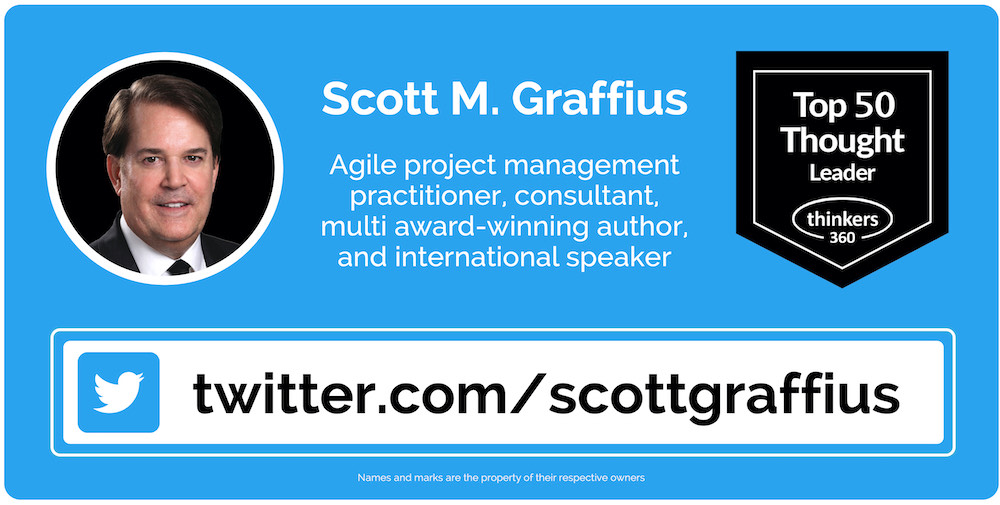

About Agile Scrum: Your Quick Start Guide with Step-by-Step Instructions

Shifting customer needs are common in today's marketplace. Businesses must be adaptive and responsive to change while delivering an exceptional customer experience to be competitive.
There are a variety of frameworks supporting the development of products and services, and most approaches fall into one of two broad categories: traditional or agile. Traditional practices such as waterfall engage sequential development, while agile involves iterative and incremental deliverables. Organizations are increasingly embracing agile to manage projects, and best meet their business needs of rapid response to change, fast delivery speed, and more.
With clear and easy to follow step-by-step instructions, Scott M. Graffius's award-winning Agile Scrum: Your Quick Start Guide with Step-by-Step Instructions helps the reader:
- Implement and use the most popular agile framework―Scrum;
- Deliver products in short cycles with rapid adaptation to change, fast time-to-market, and continuous improvement; and
- Support innovation and drive competitive advantage.
Hailed by Literary Titan as “the book highlights the versatility of Scrum beautifully.”
Winner of 17 first place awards.
Agile Scrum: Your Quick Start Guide with Step-by-Step Instructions is available in paperback and ebook/Kindle worldwide. Some links by country follow.
- 🇦🇺 Australia
- 🇦🇹 Austria
- 🇧🇪 Belgium
- 🇧🇷 Brazil
- 🇨🇦 Canada
- 🇨🇿 Czech Republic
- 🇩🇰 Denmark
- 🇫🇮 Finland
- 🇫🇷 France
- 🇩🇪 Germany
- 🇬🇷 Greece
- 🇭🇺 Hungary
- 🇮🇳 India
- 🇮🇪 Ireland
- 🇮🇱 Israel
- 🇮🇹 Italy
- 🇯🇵 Japan
- 🇱🇺 Luxembourg
- 🇲🇽 Mexico
- 🇳🇱 Netherlands
- 🇳🇿 New Zealand
- 🇳🇴 Norway
- 🇪🇸 Spain
- 🇸🇪 Sweden
- 🇨🇭 Switzerland
- 🇦🇪 UAE
- 🇬🇧 United Kingdom
- 🇺🇸 United States
- 🌏 More countries

About Agile Transformation: A Brief Story of How an Entertainment Company Developed New Capabilities and Unlocked Business Agility to Thrive in an Era of Rapid Change

Thriving in today's marketplace frequently depends on making a transformation to become more agile. Those successful in the transition enjoy faster delivery speed and ROI, higher satisfaction, continuous improvement, and additional benefits.
Based on actual events, Agile Transformation: A Brief Story of How an Entertainment Company Developed New Capabilities and Unlocked Business Agility to Thrive in an Era of Rapid Change provides a quick (60-90 minute) read about a successful agile transformation at a multinational entertainment and media company, told from the author's perspective as an agile coach.
The award-winning book by Scott M. Graffius is available in paperback and ebook/Kindle worldwide. Some links by country follow.
- 🇦🇺 Australia
- 🇦🇹 Austria
- 🇧🇷 Brazil
- 🇨🇦 Canada
- 🇨🇿 Czech Republic
- 🇩🇰 Denmark
- 🇫🇮 Finland
- 🇫🇷 France
- 🇩🇪 Germany
- 🇬🇷 Greece
- 🇮🇳 India
- 🇮🇪 Ireland
- 🇯🇵 Japan
- 🇱🇺 Luxembourg
- 🇲🇽 Mexico
- 🇳🇱 Netherlands
- 🇳🇿 New Zealand
- 🇪🇸 Spain
- 🇸🇪 Sweden
- 🇨🇭 Switzerland
- 🇦🇪 United Arab Emirates
- 🇬🇧 United Kingdom
- 🇺🇸 United States
- 🌏 More countries

Let's Connect

Connect with AgileScrumGuide.com on Facebook, Twitter, LinkedIn, Instagram, and Pinterest.
And connect with agile project management practitioner, consultant, award-winning author, and international speaker Scott M. Graffius on Twitter, Facebook, and LinkedIn.


Post-Publication Notes
Update on 10 January 2025
Scott M. Graffius periodically updates his 'Phases of Team Development' work. The most current edition is here.

© Copyright 2023 Scott M. Graffius, AgileScrumGuide.com. All rights reserved. This material may not be published, broadcast, rewritten or redistributed without the express written permission of Scott M. Graffius/AgileScrumGuide.com.

Leverage the Phases of Team Development (Forming, Storming, Norming, Performing, and Adjourning) to Help Your Teams Succeed: 2024 Update
05 January 2024


If there are any supplements or updates to this article after the date of publication, they will appear in the Post-Publication Notes section at the end of this article.


Introduction
Informed by the research of Bruce W. Tuckman and Mary Ann C. Jensen, over 100 subsequent studies, and Scott M. Graffius’ first-hand professional experience with, and analysis of, team leadership and performance, Graffius created his ‘Phases of Team Development’ as a unique perspective and visual conveying the five phases of team development — Forming, Storming, Norming, Performing, and Adjourning — inclusive of a graph showing how performance varies by phase, as well as the characteristics and strategies for each phase.
Project Managers, Scrum Masters, Agile Coaches, DevOps Leads, and other leaders can apply the information to help handle challenges or issues experienced by teams. By doing so, they’ll advance the teams’ (and their own) happiness, productivity, and success.
Graffius initially developed his unique material in 2008, and he periodically refreshes it. This article (including the accompanying visual) provides the 2024 update to his ‘Phases of Team Development’ work.
Graffius’ work has “team development” in the title. Alternative terms — which may be interchangeable in the context of this article — include group development, group dynamics, team agility, team building, team coaching, team collaboration, teamcraft, team dynamics, team leadership, team optimization, team performance, team tradecraft, and teamwork.

Five Phases of Team Development
1. Forming
Characteristics of the Forming phase include displaying eagerness, socializing, generally polite tone, sticking to safe topics, unclear about how one fits in, and some anxiety and questioning.
Strategies for Forming include taking the ‘lead,’ being highly visible, facilitating introductions, providing the ‘big picture,’ establishing clear expectations, communicating success criteria, and ensuring response times are quick.
2. Storming
Traits of the Storming phase include some resistance, lack of participation, conflict based on differences of opinions, competition, and high emotions.
Strategies for Storming include requesting and encouraging feedback, identifying issues and facilitating their resolution, normalizing matters, and building trust by honoring commitments.
3. Norming
Features of the Norming phase include developing cohesion; purpose and goals are well-understood; more confident; improved commitment; members are engaged and supportive; and relief, lowered anxiety.
Strategies for Norming include delivering feedback, recognizing individual and team efforts, providing learning/upskilling opportunities, and monitoring the ‘energy’ of the team.
4. Performing
Characteristics of the Performing phase include demonstrations of interdependence and self-management; high motivation, trust, and empathy; individuals defer to team needs; producing deliverables effectively; and consistent performance.
Strategies for Performing include ‘guiding from the side’ (minimal intervention), highlighting successes, and encouraging collective decision-making and problem-solving.
5. Adjourning
Typical traits of the Adjourning phase (also referred to as the Transitioning or Mourning phase) include potential sadness, and disbanding of temporary teams.
Strategies for Adjourning include communicating change, conducting a summative team evaluation via a retrospective or lessons learned session, recognizing individual and team efforts and achievements, and celebrating the team's accomplishments (a party/after-party).

Conclusion
Project Managers, Scrum Masters, Agile Coaches, DevOps Leads, and other leaders can apply the information in this article and the accompanying visual to help handle challenges or issues experienced by teams. By doing so, they’ll advance the teams’ (and their own) happiness, productivity, and success.
This article provided a brief overview of the five phases of team development. Scott M. Graffius presents dynamic and engaging talks and workshops on this topic and more at conferences and other events (public and private/corporate) around the world. To learn more, visit here. For booking information, please complete a speaker engagement request form or email Scott M. Graffius.
If you're looking for additional information on this article (such as references/sources, citation details, or permission request information), read on.

Graffius’ Research is Widely Cited, Featured, and Used
Businesses, scientists, journalists, professional associations, government agencies, universities, and others around the world have featured and used prior — 2023 and earlier — editions of Scott M. Graffius’ ‘Phases of Team Development’ material. Here are a few examples:
- Academic Cooperation Association
- Adobe
- American Management Association
- Amsterdam Public Health Research Institute
- Bayer
- Boston University
- CodeMonk
- Dagen
- Deimos Aerospace
- Erste Bank
- FSU College of Medicine
- Hasso Plattner Institute (Hasso-Plattner-Institut für Digital Engineering GmbH)
- IEEE
- Innovify
- Life Sciences Trainers & Educators Network (LTEN)
- London South Bank University
- New Zealand Government
- Prima Resource
- Singapore University of Social Sciences
- Technical University of Munich
- Torrens University Australia
- UK Sports Institute
- University of Galway Ireland
- University of Graz Austria
- University of Waterloo
- US National Park Service
- Virginia Tech
- Warsaw University of Technology
- Yale University
- Zittau/Gorlitz University of Applied Sciences
- And many more

References/Sources
Select (partial) bibliography:
- Activision Blizzard (2022, September 9). Tackling the Talent Shortage: Identifying the Skills Critical for Game Development. Available at: https://www.activisionblizzard.com/content/atvi/activisionblizzard/ab-touchui/ab/web/en/newsroom/2022/09/tackling-the-talent-shortage.html.
- Alfateh, Maryam Ali Abu; Messaadia, Mourad; and Ali, Mazen (2023, September). Exploring the Dynamics of Team Formation in Human-Artificial Intelligence Collaboration. In 2023 International Conference on Decision Aid Sciences and Applications (DASA), pp. 384-388, DOI: 10.1109/DASA59624.2023.10286788.
- Alford, J. (2019, April 11). Our Co-Production Journey: From Sandpits to Bird Boxes. London, United Kingdom: Imperial College London.
- Ali, A. J., Fuenzalida, J., Gómez, M., & Williams, M. J. (2021, June). Four Lenses on People Management in the Public Sector: An Evidence Review and Synthesis. Oxford Review of Economic Policy, 37 (2): 335-366.
- Amsterdam Public Health Research Institute (2021). APH Quality Handbook. Amsterdam: Amsterdam Public Health Research Institute.
- Bandai Namco (n.d.). Teamwork Makes the Dream Work. Available at: https://bandainamcomobile.com/news/power-up-your-teamwork-how-bandai-namco-mobile-builds-stronger-teams.
- Bellet, C., De Neve, J., & Ward, G. (2019 October 14). Does Employee Happiness Have an Impact on Productivity? Saïd Business School WP 2019-13. Oxford, UK: Oxford University.
- Bennett, M., Gadlin, H., & Marchand, C. (2018). Collaboration Team Science: Field Guide. Rockville, MD: National Institutes of Health.
- Berlin School of Business and Innovation (2022, September 22). How Do Technical Abilities Combined with Leadership Skills Fuel Career Growth? Available at: https://www.berlinsbi.com/blog/career-advice/how-do-technical-abilities-combined-with-leadership-skills-fuel-career-growth.
- Brief, A. P. & Weiss, H. M. (2022, February). Organizational Behavior: Affect in the Workplace. Annual Review of Psychology, 53 (1): 279-307.
- Cisco (2019). Next-Generation IT Talent Strategies: How CIOs Can Close the Skills Gap and Drive True Business Transformation. Available at: https://www.cisco.com/c/dam/global/en_uk/solutions/executive-perspectives/pdf/ITTalent.pdf.
- Couture, N. (2016, October 27). A Note About Teams. CIO. Boston, MA: International Data Group (IDG).
- Daly, L. (2002). Identify Your Project Management Team’s Level of Development and Facilitate It to Success. Paper presented at Project Management Institute Annual Seminars and Symposium, San Antonio, TX. Newtown Square, PA: Project Management Institute.
- Dechurch, Leslie; & Mesmer-Magnus, Jessica. (2010). The Cognitive Underpinnings of Effective Teamwork: A Meta-Analysis. The Journal of Applied Psychology, 95: 32-53.
- Defense Advanced Research Projects Agency (DARPA) (2023, February 23). Episode 65: A Sprint to Tomorrow, Powered by Teamwork [Podcast]. Available at: https://www.darpa.mil/news-events/2023-02-23a.
- Deloitte (2017). Digital Era Technology Operating Models, Volume 2. New York, NY: Deloitte Touche Tohmatsu Limited.
- DevOps Institute (2021). 2021 Upskilling Enterprise DevOps Skills Report. Boca Raton, FL: DevOps Institute.
- Dickinson, A.; & Stoneman, K. (1989). Individual Performance as a Function of Group Contingencies and Group Size. Journal of Organizational Behavior Management, 10: 131-150.
- Dolev, Niva, & Itzkovich, Yariv (2020). In the AI Era, Soft Skills are the New Hard Skills. In: Artificial Intelligence and Its Impact on Business, pp. 55-77. Charlotte, NC: Information Age Publishing.
- Dzombak, Rachel, & Palat, Jay (2021, August 30). 5 Ways to Start Growing an AI-Ready Workforce. Pittsburgh, PA: Software Engineering Institute, Carnegie Mellon University.
- Elliott, Joshua (n.d.). Artificial Social Intelligence for Successful Teams (ASIST). Arlington, VA: Defense Advanced Research Projects Agency (DARPA).
- Exceptional Agility (2023, January 1). Making Teams More Agile: Strategies and Benefits. Available at: https://exceptionalagility.com/blog/files/teams.html.
- Finkelstein, S. (2017, October 29). Why Companies Should Hire Teams, Not Individuals. The Wall Street Journal. New York, NY: The Wall Street Journal.
- Forbes (2018, April 23). How to Fast-Track Any Team to Success. Forbes. New York, NY: Forbes.
- Forbes (2012, October 27). How the iPad Mini is Defining Tim Cook’s Apple. Forbes. New York, NY: Forbes.
- Gartner (2020, December 15). How to Staff Your AI Team. Available at: https://www.gartner.com/smarterwithgartner/how-to-staff-your-ai-team.
- Glover, P. (2012, March 13). Team Conflict: Why It’s a Good Thing. Fast Company. New York, NY: Mansueto Ventures.
- Gorman, Austin (2023, April 27). How to Strengthen Your Soft Skills for AI and the Future of Work. Fast Company. Available at: https://www.fastcompany.com/90887540/how-to-strengthen-your-soft-skills-for-ai-and-the-future-of-work.
- Graffius, Scott M. (2023, October 13). The Science of High-Performance Game Development Teams [Presentation]. Talk delivered at the W Love Games International Video Game Development Conference 2023 - Helsinki, Finland. Digital Object Identifier (DOI): 10.13140/RG.2.2.28602.16326. DOI link: https://dx.doi.org/10.13140/RG.2.2.28602.16326.
- Graffius, Scott M. (2023, July 15). Successful Video Game Development Teams Leverage an Extensive Range of Hard Skills and Soft Skills. Available at: https://scottgraffius.com/blog/files/gamedev.html. DOI: 10.13140/RG.2.2.31205.17124.
- Graffius, Scott M. (2023, April 26). The Science of High-Performance Teams [Presentation]. Talk delivered at the DevOps Institute’s SKILup Day 2023 Conference. Digital Object Identifier (DOI): 10.13140/RG.2.2.15888.28169. DOI link: https://dx.doi.org/10.13140/RG.2.2.15888.28169.
- Graffius, Scott M. (2023, January 9). Use the Phases of Team Development (Based on Bruce W. Tuckman's Model of Forming, Storming, Norming, Performing, and Adjourning) to Help Teams Grow and Advance: 2023 Update. Available at: https://scottgraffius.com. Digital Object Identifier (DOI): 10.13140/RG.2.2.10720.35846. DOI link: https://dx.doi.org/10.13140/RG.2.2.10720.35846.
- Graffius, Scott M. (2023, June 29). What Successful AI Teams Have in Common [Presentation]. Talk delivered at Conf42 Quantum Computing 2023 Conference. Digital Object Identifier (DOI): 10.13140/RG.2.2.29382.45120. DOI link: https://dx.doi.org/10.13140/RG.2.2.29382.45120.
- Graffius, Scott M. (2023, May 1). Fueling the Development of Innovative and Life-Changing AI Solutions [Presentation]. Talk delivered to an audience of Technology professionals (including Data Scientists, Machine Learning Engineers, Data Engineers, AI Researchers, Project Managers, Business Analysts, UX Designers, Software Developers, Cloud Architects, Data Privacy and Security Specialists, and others involved or interested in AI) at a private event in Mountain View, California, United States. Digital Object Identifier (DOI): 10.13140/RG.2.2.27956.73601. DOI link: https://dx.doi.org/10.13140/RG.2.2.27956.73601.
- Graffius, Scott M. (2022, February 4). Team Development Tradecraft: A Source of Competitive Advantage [Workshop]. Session at private event in Adelaide, Australia. DOI: 10.13140/RG.2.2.14092.80002.
- Graffius, Scott M. (2022, May 13). Want Happier and More Productive DevOps Teams? [Presentation]. Talk delivered at DevOpsDays Geneva, Switzerland 2022 Conference. Digital Object Identifier (DOI): 10.13140/RG.2.2.22252.85127. DOI link: https://dx.doi.org/10.13140/RG.2.2.22252.85127.
- Graffius, Scott M. (2021, February 20). But First, the Team! [Presentation]. Talk delivered at the Brno, Czech Republic DevConf.CZ 2021 Conference. Digital Object Identifier (DOI): 10.13140/RG.2.2.29016.72964. DOI link: https://dx.doi.org/10.13140/RG.2.2.29016.72964.
- Graffius, Scott M. (2021, June 21). DevOps and Team Leadership [Workshop]. Session at private event in Las Vegas, NV. DOI: 10.13140/RG.2.2.15380.22401.
- Graffius, Scott M. (2021, May 13). But First, the Team! [Presentation]. Lecture delivered at DevOps Pro Europe 2021 Conference. Based and simulcast live from Vilnius, Lithuania. DOI: 10.13140/RG.2.2.30524.36481.
- Graffius, Scott M. (2021, November 10). An Error Was Introduced Into the Seventh Edition of 'A Guide to the Project Management Body of Knowledge (PMBOK).’ Los Angeles, CA: Scott M. Graffius.
- Graffius, Scott M. (2021, November 8). Bruce Tuckman’s Model (Forming, Storming, Norming, Performing, and Adjourning) is Highly Relevant and Beneficial, But It Doesn’t Please Everyone. Los Angeles, CA: Scott M. Graffius.
- Graffius, Scott M. (2021, October 5). Navigate the Phases of Team Development with Speed and Agility for Happier and More Productive Teams [Presentation]. Talk delivered at the Institute of Electrical and Electronics Engineers IEEE Day 2021 Conference. Digital Object Identifier (DOI): 10.13140/RG.2.2.20055.19365. DOI link: https://dx.doi.org/10.13140/RG.2.2.20055.19365.
- Graffius, Scott M. (2021). Phases of Team Development. Los Angeles, CA: Scott M. Graffius. Digital Object Identifier (DOI): 10.13140/RG.2.2.22040.42246.
- Graffius, Scott M. (2018, October 18). Agile Scrum Helps Innovators, Disruptors, and Entrepreneurs Develop and Deliver Products at Astounding Speed Which Drives Competitive Advantage [Presentation]. Talk delivered at Techstars Startup Week Conference. DOI: 10.13140/RG.2.2.25009.12647.
- Himmelstein, D. (2018, January 26). Team Cycles and Culture Development. San Jose, CA: Acer, Inc.
- Humphrey, W. S., Chick, T. A., Nichols, W., and Pomeroy-Huff, M. (2010). Software Engineering Institute’s Team Software Process Body of Knowledge. Pittsburgh, PA: Carnegie Mellon University.
- Infinity Ward (n.d.). Infinity Ward. Available at: https://www.infinityward.com.
- International Game Developers Association (IGDA) (n.d.). IGDA Foundation. Available at: https://igda.org/igda-foundation/.
- Jovanovic, M., Mesquida, A., Radaković, N., & Mas, A. (2016). Agile Retrospective Games for Different Team Development Phases. Journal of Universal Computer Science, 22: 1489-1508.
- KPMG (2017). The Digital Fund, Season 2. Amstelveen, Netherlands: KPMG International.
- Leswing, Kif (2023, June 5). Apple’s Practical Approach to A.I.: No Bragging, Just Features. CNBC. Available at: https://www.cnbc.com/2023/06/05/apple-practical-approach-to-ai-no-bragging-just-features.html.
- Life Sciences Trainers and Educators Network (LTEN) (2022). Leveraging a Cross-Functional Training Task Force to Create Training that Doesn’t Suck. LTEN 2022 Conference.
- Madden, D. (2019, May 19). The Four Stages of Building a Great Team – and the One Where Things Usually Go Wrong. Inc. Magazine. New York, NY: Inc. Magazine.
- Makar, A. (2011, July 13). Lessons Learned in Norming and Performing Team Development Phases. Louisville, KY: Tech Republic.
- Martinuzzi, B. (2012, June 8). Six Tips Guaranteed to Reduce Workplace Frustrations. New York, NY: American Express Company.
- Massachusetts Institute of Technology (MIT) (2021, January). Cognitive Science as a New People Science for the Future of Work. Available at: https://workofthefuture.mit.edu/wp-content/uploads/2021/01/2021-Research-Brief-Polli-Kassir-Dolphin-Baker-Gabrieli.pdf.
- Microsoft (2019, June 15). Is the Latest Technology the Key to Your Team’s Success, or is There Something Else? Microsoft Developer Support. Accessed at: https://devblogs.microsoft.com/premier-developer/is-the-latest-technology-the-key-to-your-teams-success-or-is-there-something-else. Redmond, WA: Microsoft.
- Mocko, G., & Linnerud, B. (2016). Measuring the Effects of Goal Alignment on Innovative Engineering Design Projects. International Journal of Engineering Education, 32: 55-63.
- Negrón, A.P.P., Carranza, D.B., Muñoz, M. (2023). Video Game Development Process for Soft Skills Analysis. In: Mejia, J., Muñoz, M., Rocha, Á., Hernández-Nava, V. (eds), New Perspectives in Software Engineering. Proceedings of the 11th International Conference on Software Process Improvement (CIMPS 2022). Lecture Notes in Networks and Systems, vol. 576. New York, NY: Springer.
- Riggs, A. (2020, October 15). Why I Start All My Video Meetings with Collaborative Games (Spoiler: It’s Not Boredom). Amsterdam, the Netherlands: The Next Web (TNW).
- Romanelli, M. (2019, September 11). Teamwork Accelerated. PM Times. Newmarket, Ontario, Canada: Macgregor Communications.
- Rowley, D., & Lange, M. (2007). Forming to Performing: The Evolution of an Agile Team. IEEE Computer Society Proceedings. Agile 2007, 1: 408-414.
- Sakpal, M. (2020, March 3. Learn How to Debunk These Five Restructuring Myths. Stamford, CT: Gartner, Inc.
- Sazali, A. R. B.; Khamarudin, F. B.; & Abdul Alahdad, S. N. B. (2022). Maximising the Zone of Proximal Development Benefits in Group Online Learning. International Journal of Academic Research in Business and Social Sciences, 12 (6): 1476-1496.
- Scaled Agile, Inc. (2023, March 14). Working Successfully in Agile with Remote Team Members. Available at: https://scaledagileframework.com/working-successfully-in-agile-with-remote-team-members/.
- Scrum Alliance (2020). Learning Objectives Examples. Denver, CO: Scrum Alliance.
- Stanford University (2019, September). Gathering Strength, Gathering Storms. Stanford, CA: Stanford University.
- Steiner, Ivan D. (1972). Group Process and Productivity. New York, New York: Academic Press.
- Stern, S. (2018, September 26). Is Your Team Working the Rory Underwood Way? Financial Times. London, United Kingdom: The Financial Times, a Nikkei Company.
- Tamiru, Natasha (2023, June). Team Dynamics: Five Keys to Building Effective Teams. Google. Available at: https://www.thinkwithgoogle.com/intl/en-emea/consumer-insights/consumer-trends/five-dynamics-effective-team.
- Tannenbaum, Robert, & Schmidt, Warren H. (1958). How to Choose a Leadership Pattern. Harvard Business Review, 36: 95- 101.
- Telford, R. (2013, June 4). This is Where It Gets Interesting. Armonk, NY: International Business Machines (IBM) Corporation.
- Thier, Jane (2021, December 8). 'Form, Storm, Norm, Perform’: Twitter’s New CEO Faces a Critical Few Months as He Seeks to Differentiate Himself from Jack Dorsey, Leadership Experts Say. Fortune. Available at: https://fortune.com/2021/12/08/form-storm-norm-perform-twitters-new-ceo-faces-a-critical-few-months-as-he-seeks-to-differentiate-himself-from-jack-dorsey-leadership-experts-say/.
- Tuckman, B. W. (1965). Developmental Sequence in Small Groups. Psychological Bulletin, 63: 384-399.
- Tuckman, B. W., & Jensen, M. A. C. (1977). Stages of Small-Group Development Revisited. Group and Organizational Studies, 2 (4): 419-427.
- United States Army (2015). Innovative Learning: A Key to National Security. Washington, DC: United States Army.
- United States National Park Service (NPS) (2022, Spring). NPS Aviation Safety.

How to Cite This Article
Graffius, Scott M. (2024, January 5). Leverage the Phases of Team Development (Forming, Storming, Norming, Performing, and Adjourning) to Help Your Teams Succeed: 2024 Update. Available at: https://agilescrumguide.com/blog/files/team-dev-2024.html.

Permission Request Information
Contact Scott M. Graffius to request permission to use his copyrighted 'Phases of Team Development' visual or other material.

About Scott M. Graffius

Scott M. Graffius, PMP, SA, CSP-SM, CSP-PO, CSM, CSPO, SFE, ITIL, LSSGB is an agile project management practitioner, consultant, multi-award-winning author, and international keynote speaker. He is the Founder of Exceptional PPM and PMO Solutions™ and subsidiary Exceptional Agility™. He has generated over $1.9 billion of business value in aggregate for Global Fortune 500 businesses and other organizations he has served. Graffius and content from his books (Agile Scrum: Your Quick Start Guide with Step-by-Step Instructions and Agile Transformation: A Brief Story of How an Entertainment Company Developed New Capabilities and Unlocked Business Agility to Thrive in an Era of Rapid Change), talks, workshops, and more have been featured and used by businesses, professional associations, governments, and universities. Examples include Microsoft, Oracle, Broadcom, Cisco, Gartner, Project Management Institute, IEEE, Qantas, National Academy of Sciences, United States Department of Energy, New Zealand Ministry of Education, Yale University, Tufts University, and others. He has delighted audiences with dynamic and engaging talks and workshops on agile, project management, and technology leadership at 89 conferences and other events across 25 countries.
Connect with Scott on:
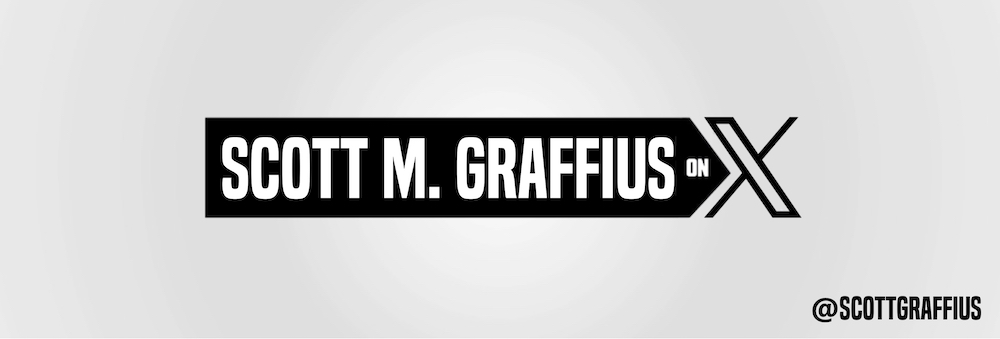

About Agile Scrum: Your Quick Start Guide with Step-by-Step Instructions
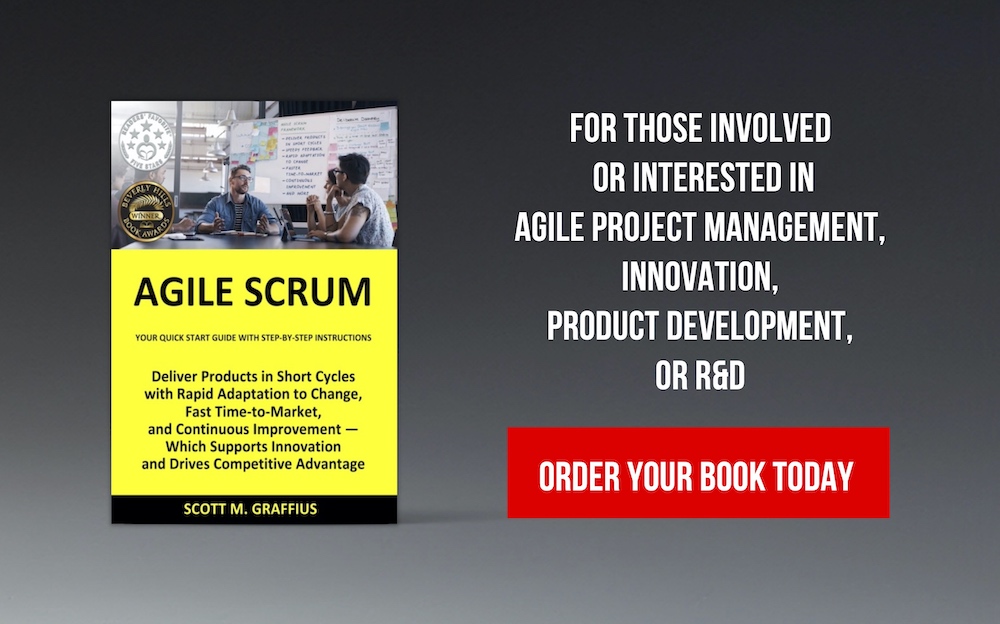
Shifting customer needs are common in today's marketplace. Businesses must be adaptive and responsive to change while delivering an exceptional customer experience to be competitive.
There are a variety of frameworks supporting the development of products and services, and most approaches fall into one of two broad categories: traditional or agile. Traditional practices such as waterfall engage sequential development, while agile involves iterative and incremental deliverables. Organizations are increasingly embracing agile to manage projects, and best meet their business needs of rapid response to change, fast delivery speed, and more.
With clear and easy to follow step-by-step instructions, Scott M. Graffius's award-winning Agile Scrum: Your Quick Start Guide with Step-by-Step Instructions helps the reader:
- Implement and use the most popular agile framework―Scrum;
- Deliver products in short cycles with rapid adaptation to change, fast time-to-market, and continuous improvement; and
- Support innovation and drive competitive advantage.
Hailed by Literary Titan as “the book highlights the versatility of Scrum beautifully.”
Winner of 17 first place awards.
Agile Scrum: Your Quick Start Guide with Step-by-Step Instructions is available in paperback and ebook/Kindle worldwide. Some links by country follow.
- 🇦🇺 Australia
- 🇦🇹 Austria
- 🇧🇪 Belgium
- 🇧🇷 Brazil
- 🇨🇦 Canada
- 🇨🇿 Czech Republic
- 🇩🇰 Denmark
- 🇫🇮 Finland
- 🇫🇷 France
- 🇩🇪 Germany
- 🇬🇷 Greece
- 🇭🇺 Hungary
- 🇮🇳 India
- 🇮🇪 Ireland
- 🇮🇱 Israel
- 🇮🇹 Italy
- 🇯🇵 Japan
- 🇱🇺 Luxembourg
- 🇲🇽 Mexico
- 🇳🇱 Netherlands
- 🇳🇿 New Zealand
- 🇳🇴 Norway
- 🇪🇸 Spain
- 🇸🇪 Sweden
- 🇨🇭 Switzerland
- 🇦🇪 UAE
- 🇬🇧 United Kingdom
- 🇺🇸 United States
- 🌏 More countries

About Agile Transformation: A Brief Story of How an Entertainment Company Developed New Capabilities and Unlocked Business Agility to Thrive in an Era of Rapid Change

Thriving in today's marketplace frequently depends on making a transformation to become more agile. Those successful in the transition enjoy faster delivery speed and ROI, higher satisfaction, continuous improvement, and additional benefits.
Based on actual events, Agile Transformation: A Brief Story of How an Entertainment Company Developed New Capabilities and Unlocked Business Agility to Thrive in an Era of Rapid Change provides a quick (60-90 minute) read about a successful agile transformation at a multinational entertainment and media company, told from the author's perspective as an agile coach.
The award-winning book by Scott M. Graffius is available in paperback and ebook/Kindle worldwide. Some links by country follow.
- 🇦🇺 Australia
- 🇦🇹 Austria
- 🇧🇷 Brazil
- 🇨🇦 Canada
- 🇨🇿 Czech Republic
- 🇩🇰 Denmark
- 🇫🇮 Finland
- 🇫🇷 France
- 🇩🇪 Germany
- 🇬🇷 Greece
- 🇮🇳 India
- 🇮🇪 Ireland
- 🇯🇵 Japan
- 🇱🇺 Luxembourg
- 🇲🇽 Mexico
- 🇳🇱 Netherlands
- 🇳🇿 New Zealand
- 🇪🇸 Spain
- 🇸🇪 Sweden
- 🇨🇭 Switzerland
- 🇦🇪 United Arab Emirates
- 🇬🇧 United Kingdom
- 🇺🇸 United States
- 🌏 More countries

Let's Connect

Connect with AgileScrumGuide.com on:
And connect with agile project management practitioner, consultant, award-winning author, and international speaker Scott M. Graffius on:


Post-Publication Notes
Update on 10 January 2025
Scott M. Graffius periodically updates his 'Phases of Team Development' work. The most current edition is here.

© Copyright 2024 Scott M. Graffius, AgileScrumGuide.com. All rights reserved. This material may not be published, broadcast, rewritten or redistributed without the express written permission of Scott M. Graffius/AgileScrumGuide.com. .


AgileScrumGuide.com Review of 15 Agile Project Management Tools
26 February 2024
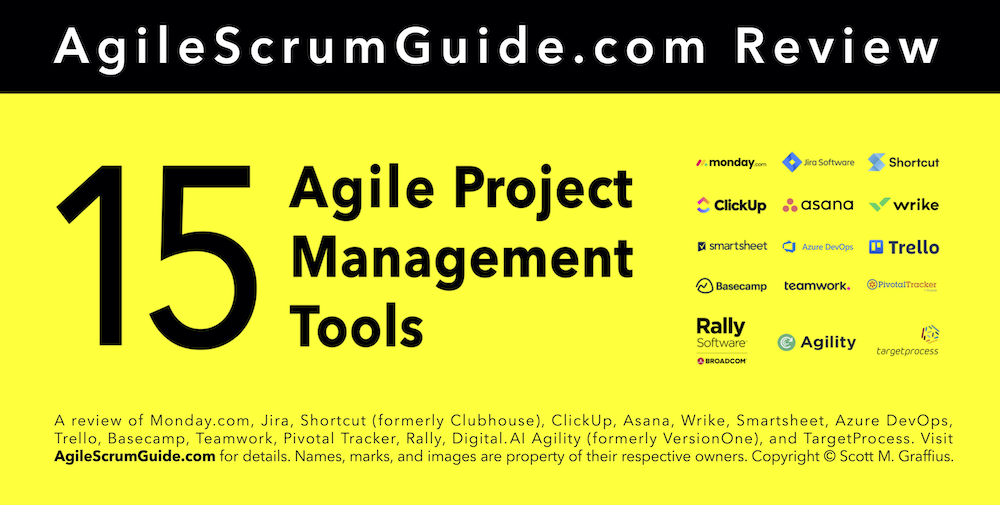

Introduction
Projects are the vehicles and project management is the engine for organizational success. Strategic objectives and other initiatives are fulfilled by projects — endeavors undertaken to create a unique product, service, or result. The art and science of project management — the application of knowledge, skills, tools, and techniques to projects — is indispensable for the management and completion of projects.
Tools can make a significant contribution to the success of projects. This report provides a unique high standard, side-by-side review of 15 Agile project management tools. Those interested in selecting a related product can leverage the information presented here to assist in their decision-making.
Now, on to the review!



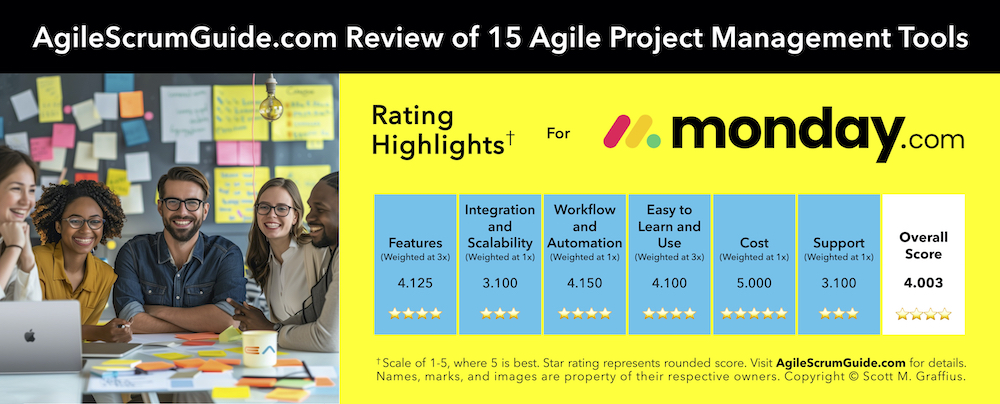
#1
Monday(dot)com
Overall Score (on a scale of 1-5, where 5 is best): 4.003
- Features: 4.125
- Integration and Scalability: 3.100
- Workflow and Automation: 4.150
- Easy to Use and Understand: 4.100
- Cost: 5.000
- Support: 3.100
Additional Information
- Abridged product description or slogan from company: "The #1 Work Management Platform For All Teams"
- Company: Monday(dot)com
- Headquarters: Tel Aviv-Yafo, Israel
- Website: https://monday.com
- 𝐗 (formerly Twitter): @mondaydotcom - https://twitter.com/mondaydotcom
Also see the FAQs section of this article.

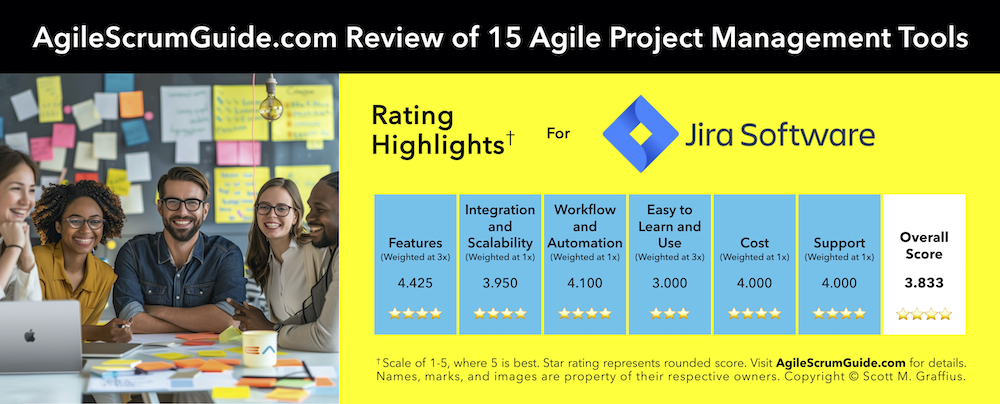
#2
Jira
Overall Score (on a scale of 1-5, where 5 is best): 3.833
- Features: 4.425
- Integration and Scalability: 3.950
- Workflow and Automation: 4.100
- Easy to Use and Understand: 3.000
- Cost: 4.000
- Support: 4.000
Additional Information
- Abridged product description or slogan from company: "Move fast, stay aligned, and build better - together"
- Company: Atlassian
- Headquarters: Sydney, Australia
- Website: https://www.atlassian.com
- 𝐗 (formerly Twitter): @Jira - https://twitter.com/Jira
Also see the FAQs section of this article.


#3
Shortcut (formerly Clubhouse)
Overall Score (on a scale of 1-5, where 5 is best): 3.746
- Features: 4.120
- Integration and Scalability: 3.100
- Workflow and Automation: 3.000
- Easy to Use and Understand: 4.000
- Cost: 4.000
- Support: 3.000
Additional Information
- Abridged product description or slogan from company: "Shortcut aligns product development work with company objectives so teams can execute with a shared purpose"
- Company: Shortcut Software Company
- Headquarters: New York City, New York, United States
- Website: https://www.shortcut.com
- 𝐗 (formerly Twitter): @shortcut - https://twitter.com/shortcut
Also see the FAQs section of this article.


#4
ClickUp
Overall Score (on a scale of 1-5, where 5 is best): 3.703
- Features: 4.125
- Integration and Scalability: 3.350
- Workflow and Automation: 4.000
- Easy to Use and Understand: 3.100
- Cost: 5.000
- Support: 3.000
Additional Information
- Abridged product description or slogan from company: "Get everyone working in a single platform designed to manage any type of work"
- Company: Mango Technologies, Inc.
- Headquarters: San Diego, California, United States
- Website: https://clickup.com
- 𝐗 (formerly Twitter): @clickup - https://twitter.com/clickup
Also see the FAQs section of this article.

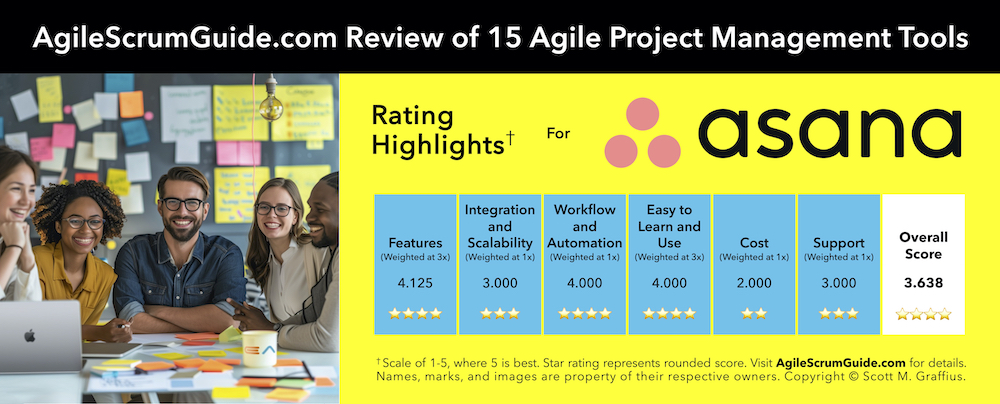
#5
Asana
Overall Score (on a scale of 1-5, where 5 is best): 3.638
- Features: 4.125
- Integration and Scalability: 3.000
- Workflow and Automation: 4.000
- Easy to Use and Understand: 4.000
- Cost: 2.000
- Support: 3.000
Additional Information
- Abridged product description or slogan from company: "Make it easier for your team to do more work that matters"
- Company: Asana, Inc.
- Headquarters: San Francisco, California, United States
- Website: https://asana.com
- 𝐗 (formerly Twitter): @asana - https://twitter.com/asana
Also see the FAQs section of this article.


#6
Wrike
Overall Score (on a scale of 1-5, where 5 is best): 3.516
- Features: 3.720
- Integration and Scalability: 3.000
- Workflow and Automation: 4.000
- Easy to Use and Understand: 3.000
- Cost: 5.000
- Support: 3.000
Additional Information
- Abridged product description or slogan from company: "One platform to
- streamline all workflows"
- Company: Citrix Systems
- Headquarters: San Jose, California, United States
- Website: https://www.wrike.com
- 𝐗 (formerly Twitter): @wrike - https://twitter.com/wrike
Also see the FAQs section of this article.

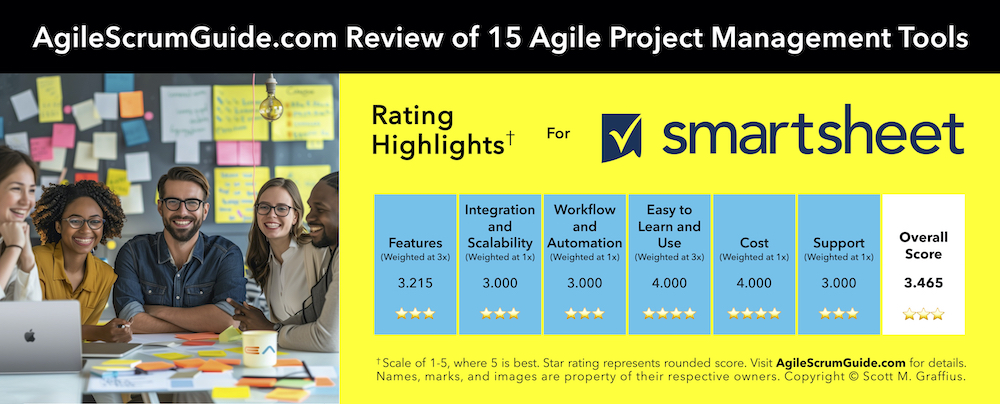
#7
Smartsheet
Overall Score (on a scale of 1-5, where 5 is best): 3.465
- Features: 3.215
- Integration and Scalability: 3.000
- Workflow and Automation: 3.000
- Easy to Use and Understand: 4.000
- Cost: 4.000
- Support: 3.000
Additional Information
- Abridged product description or slogan from company: "The enterprise work management platform"
- Company: Smartsheet, Inc.
- Headquarters: Bellevue, Washington, United States
- Website: https://www.smartsheet.com
- 𝐗 (formerly Twitter): @Smartsheet - https://twitter.com/smartsheet
Also see the FAQs section of this article.


#8
Azure DevOps
Overall Score (on a scale of 1-5, where 5 is best): 3.455
- Features: 3.850
- Integration and Scalability: 4.000
- Workflow and Automation: 4.000
- Easy to Use and Understand: 3.000
- Cost: 2.000
- Support: 4.000
Additional Information
- Abridged product description or slogan from company: "Plan smarter, collaborate better, and ship faster with a set of modern dev services"
- Company: Microsoft
- Headquarters: Redmond, Washington, United States
- Website: https://azure.microsoft.com/en-us/products/devops
- 𝐗 (formerly Twitter): @Azure - https://twitter.com/azure
Also see the FAQs section of this article.


#9
Trello
Overall Score (on a scale of 1-5, where 5 is best): 3.338
- Features: 3.125
- Integration and Scalability: 3.000
- Workflow and Automation: 3.000
- Easy to Use and Understand: 4.000
- Cost: 3.000
- Support: 3.000
Additional Information
- Abridged product description or slogan from company: "Trello brings all your tasks, teammates, and tools together"
- Company: Atlassian
- Headquarters: Sydney, Australia
- Website: https://trello.com
- 𝐗 (formerly Twitter): @trello - https://twitter.com/trello
Also see the FAQs section of this article.

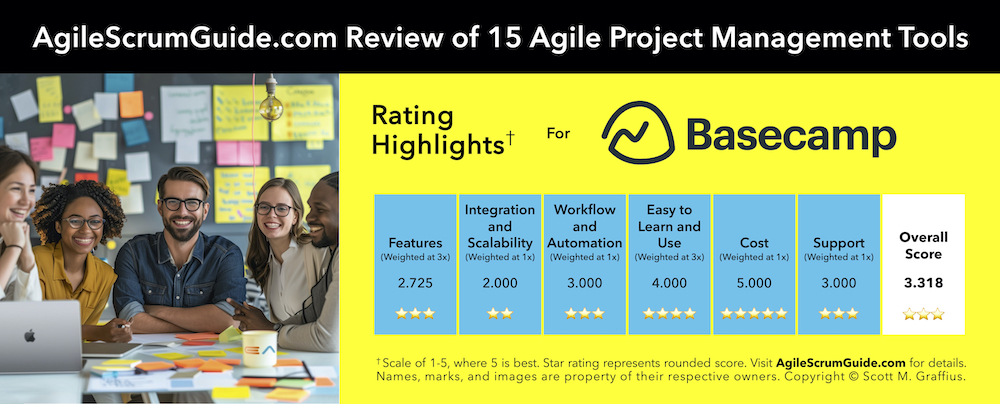
#10
Basecamp
Overall Score (on a scale of 1-5, where 5 is best): 3.318
- Features: 2.725
- Integration and Scalability: 2.000
- Workflow and Automation: 3.000
- Easy to Use and Understand: 4.000
- Cost: 5.000
- Support: 3.000
Additional Information
- Abridged product description or slogan from company: "Basecamp’s the project management platform that helps small teams move faster and make more progress than they ever thought possible"
- Company: 37signals
- Headquarters: Chicago, Illinois, United States
- Website: https://basecamp.com
- 𝐗 (formerly Twitter): @basecamp - https://twitter.com/basecamp
Also see the FAQs section of this article.

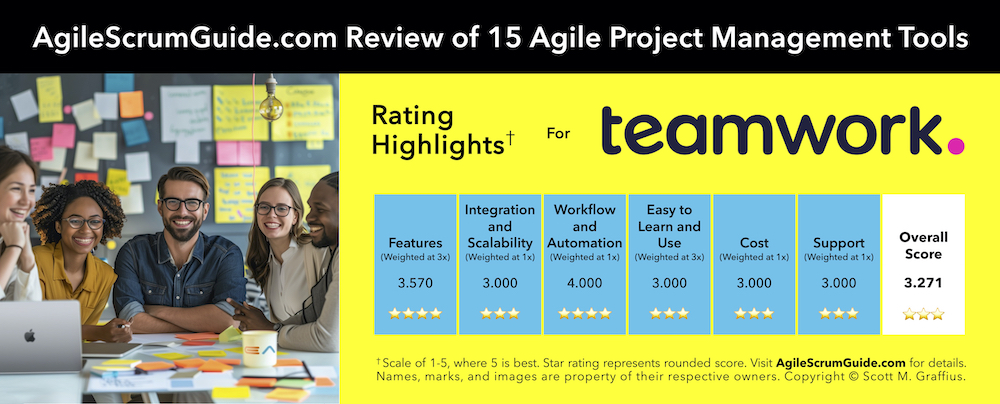
#11
Teamwork
Overall Score (on a scale of 1-5, where 5 is best): 3.271
- Features: 3.570
- Integration and Scalability: 3.000
- Workflow and Automation: 4.000
- Easy to Use and Understand: 3.000
- Cost: 3.000
- Support: 3.000
Additional Information
- Abridged product description or slogan from company: "The all-in-one team platform to manage every aspect of your client work"
- Company: Teamwork(dot)com Ltd
- Headquarters: Blackpool, Cork, Ireland
- Website: https://www.teamwork.com
- 𝐗 (formerly Twitter): @teamwork - https://twitter.com/teamwork
Also see the FAQs section of this article.

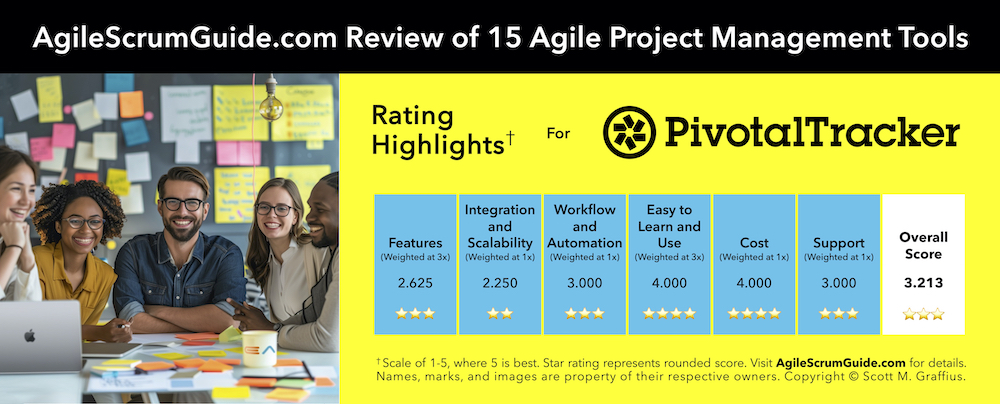
#12
Pivotal Tracker
Overall Score (on a scale of 1-5, where 5 is best): 3.213
- Features: 2.625
- Integration and Scalability: 2.250
- Workflow and Automation: 3.000
- Easy to Use and Understand: 4.000
- Cost: 4.000
- Support: 3.000
Additional Information
- Abridged product description or slogan from company: "Proven project management for successful teams"
- Company: VMware
- Headquarters: San Francisco, California, United States
- Website: https://www.pivotaltracker.com
- 𝐗 (formerly Twitter): @pivotaltracker - https://twitter.com/pivotaltracker
Also see the FAQs section of this article.

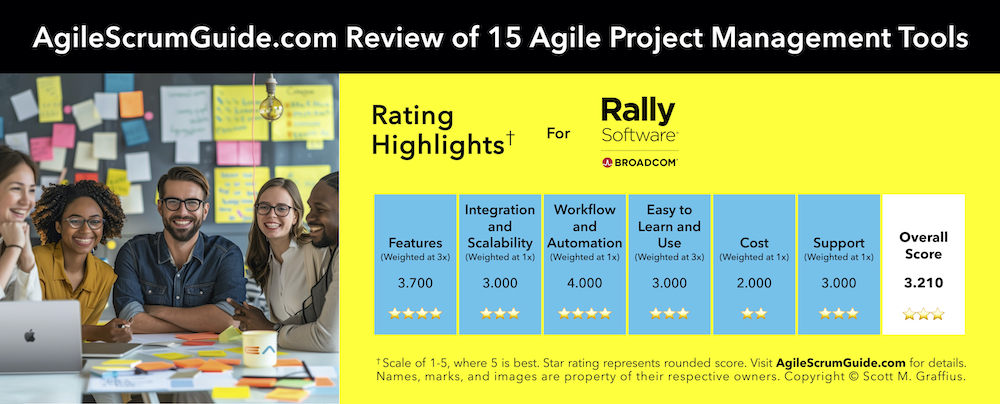
#13
Rally
Overall Score (on a scale of 1-5, where 5 is best): 3.210
- Features: 3.700
- Integration and Scalability: 3.000
- Workflow and Automation: 4.000
- Easy to Use and Understand: 3.000
- Cost: 2.000
- Support: 3.000
Additional Information
- Abridged product description or slogan from company: "Rally is purpose built for enterprise agility at scale"
- Company: Broadcom
- Headquarters: San Jose, California, United States
- Website: https://www.broadcom.com/products/software/value-stream-management/rally
- 𝐗 (formerly Twitter): @Broadcom - https://twitter.com/Broadcom
Also see the FAQs section of this article.


#14
Digital(dot)AI Agility (formerly VersionOne)
Overall Score (on a scale of 1-5, where 5 is best): 3.189
- Features: 3.630
- Integration and Scalability: 3.000
- Workflow and Automation: 4.000
- Easy to Use and Understand: 3.000
- Cost: 2.000
- Support: 3.000
Additional Information
- Abridged product description or slogan from company: "Digital.ai Agility is the industry-leading enterprise Agile planning solution driving efficiency by scaling Agile practices across all levels"
- Company: Digital(dot)AI Software, Inc.
- Headquarters: Raleigh, North Carolina, United States
- Website: https://digital.ai/products/agility/
- 𝐗 (formerly Twitter): @digitaldotai - https://twitter.com/digitaldotai
Also see the FAQs section of this article.


#15
Targetprocess
Overall Score (on a scale of 1-5, where 5 is best): 3.180
- Features: 3.600
- Integration and Scalability: 3.000
- Workflow and Automation: 4.000
- Easy to Use and Understand: 3.000
- Cost: 2.000
- Support: 3.000
Additional Information
- Abridged product description or slogan from company: "Enterprise Agile made easy"
- Company: Appito, an IBM Company
- Headquarters: Bellevue, Washington, United States
- Website: https://www.apptio.com/products/targetprocess/
- 𝐗 (formerly Twitter): @Apptio - https://twitter.com/Apptio
Also see the FAQs section of this article.


Conclusion
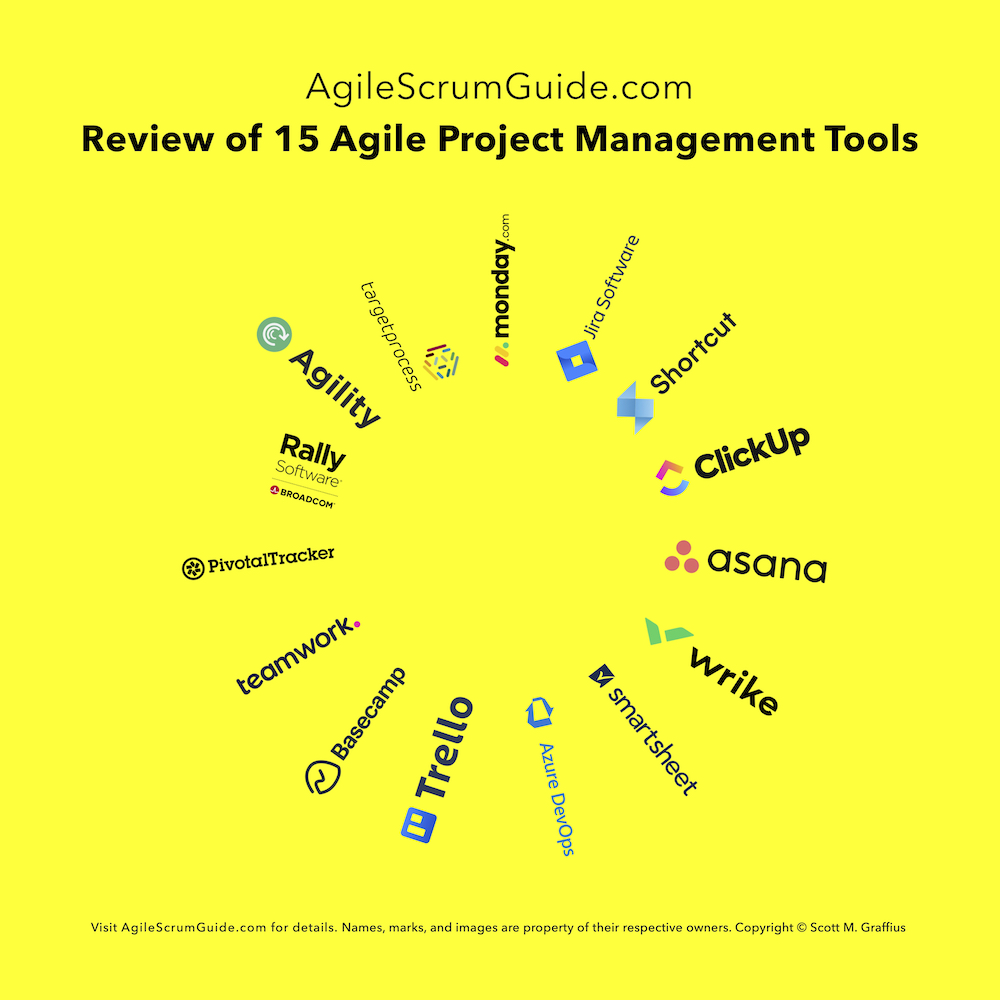
Tools can help advance the successful management and completion of projects. This report provided a unique multi-criteria, high standard, side-by-side review of 15 Agile project management tools. Those interested in selecting a related product can leverage the information to assist in their decision-making.



Frequently Asked Questions (FAQs)
Q: Did the assessment review free, paid, or both free and paid versions of the tools? A: The review assessed only paid versions of products in order to evaluate their complete set of features and full potential.
Q: What factors were assessed? A: The review assessed six factors: features (weighted at 3x), integration and scalability (weighted at 1x), workflow and automation (weighted at 1x), easy to learn and use (weighted at 3x), cost (weighted at 1x), and support (weighted at 1x).
Q: Why were two factors — features, and easy to learn and use — weighted more heavily in the assessment? A: Those two factors were prioritized by weighing each at 3x due to their fundamental role in user adoption and experience.
Q: What was the rating scale? A: The numerical scale was 1-5, with 5 being best. The report also included star ratings, which represented the respective rounded score. For example, a score of 3.833 rounded to 4, so 4 stars were shown in that case.
Q: Why did none of the tools receive the overall rating of five stars? A: The evaluation employed a rigorous set of criteria and had very high standards for what would constitute a five-star rating. As described earlier, the overall score was comprised of six factors. For those constituent factors, some products scored the maximum of 5.000, which translated to five stars. For the overall score, however, none of the tools received a score which would be equivalent to five stars. Monday(dot)com received the highest overall score; it was 4.003, which translated to four stars.
Q: Is there a qualitative analog (such as 'good' or 'great') in addition to the numerical scores and star ratings? A: Adapted from IGN's rating system, a supplemental scale for this review is delineated as: 'awful' 1.0 to 1.5, 'bad' 1.6 to 2.0, 'mediocre' 2.1 to 2.5, 'okay' 2.6 to 3.0, 'good' 3.1 to 3.5, 'great' 3.6 to 4.0, 'amazing' 4.1 to 4.5, and 'masterpiece' 4.6 to 5.0. The overall scores for tools in this review ranged from 3.180 to 4.003. Overlaying the overall scores on the supplemental scale, ten tools are 'good' and five tools are 'great.'


How to Cite This Article
Graffius, Scott M. (2024, February 26). AgileScrumGuide.com Review of 15 Agile Project Management Tools. Available at: https://agilescrumguide.com/blog/files/15-tools-2024.html. DOI: 10.13140/RG.2.2.16887.80800.



About Scott M. Graffius

Scott M. Graffius, PMP, SA, CSP-SM, CSP-PO, CSM, CSPO, ITIL, LSSGB is an agile project management practitioner, consultant, multi-award-winning author, and international keynote speaker. He is the Founder of Exceptional PPM and PMO Solutions™ and subsidiary Exceptional Agility™. He has generated over $1.9 billion of business value in aggregate for Global Fortune 500 businesses and other organizations he has served. Graffius and content from his books (Agile Scrum: Your Quick Start Guide with Step-by-Step Instructions and Agile Transformation: A Brief Story of How an Entertainment Company Developed New Capabilities and Unlocked Business Agility to Thrive in an Era of Rapid Change), talks, workshops, and more have been featured and used by businesses, professional associations, governments, and universities. Examples include Microsoft, Oracle, Broadcom, Cisco, Gartner, Project Management Institute, IEEE, Qantas, National Academy of Sciences, United States Department of Energy, New Zealand Ministry of Education, Yale University, Tufts University, and others. He has delighted audiences with dynamic and engaging talks and workshops on agile, project management, and technology leadership at 89 conferences and other events across 25 countries.
Connect with Scott on:

About Agile Scrum: Your Quick Start Guide with Step-by-Step Instructions

Shifting customer needs are common in today's marketplace. Businesses must be adaptive and responsive to change while delivering an exceptional customer experience to be competitive.
There are a variety of frameworks supporting the development of products and services, and most approaches fall into one of two broad categories: traditional or agile. Traditional practices such as waterfall engage sequential development, while agile involves iterative and incremental deliverables. Organizations are increasingly embracing agile to manage projects, and best meet their business needs of rapid response to change, fast delivery speed, and more.
With clear and easy to follow step-by-step instructions, Scott M. Graffius's award-winning Agile Scrum: Your Quick Start Guide with Step-by-Step Instructions helps the reader:
- Implement and use the most popular agile framework―Scrum;
- Deliver products in short cycles with rapid adaptation to change, fast time-to-market, and continuous improvement; and
- Support innovation and drive competitive advantage.
Hailed by Literary Titan as “the book highlights the versatility of Scrum beautifully.”
Winner of 17 first place awards.
Agile Scrum: Your Quick Start Guide with Step-by-Step Instructions is available in paperback and ebook/Kindle worldwide. Some links by country follow.
- 🇦🇺 Australia
- 🇦🇹 Austria
- 🇧🇪 Belgium
- 🇧🇷 Brazil
- 🇨🇦 Canada
- 🇨🇿 Czech Republic
- 🇩🇰 Denmark
- 🇫🇮 Finland
- 🇫🇷 France
- 🇩🇪 Germany
- 🇬🇷 Greece
- 🇭🇺 Hungary
- 🇮🇳 India
- 🇮🇪 Ireland
- 🇮🇱 Israel
- 🇮🇹 Italy
- 🇯🇵 Japan
- 🇱🇺 Luxembourg
- 🇲🇽 Mexico
- 🇳🇱 Netherlands
- 🇳🇿 New Zealand
- 🇳🇴 Norway
- 🇪🇸 Spain
- 🇸🇪 Sweden
- 🇨🇭 Switzerland
- 🇦🇪 UAE
- 🇬🇧 United Kingdom
- 🇺🇸 United States
- 🌏 More countries

About Agile Transformation: A Brief Story of How an Entertainment Company Developed New Capabilities and Unlocked Business Agility to Thrive in an Era of Rapid Change

Thriving in today's marketplace frequently depends on making a transformation to become more agile. Those successful in the transition enjoy faster delivery speed and ROI, higher satisfaction, continuous improvement, and additional benefits.
Based on actual events, Agile Transformation: A Brief Story of How an Entertainment Company Developed New Capabilities and Unlocked Business Agility to Thrive in an Era of Rapid Change provides a quick (60-90 minute) read about a successful agile transformation at a multinational entertainment and media company, told from the author's perspective as an agile coach.
The award-winning book by Scott M. Graffius is available in paperback and ebook/Kindle worldwide. Some links by country follow.
- 🇦🇺 Australia
- 🇦🇹 Austria
- 🇧🇷 Brazil
- 🇨🇦 Canada
- 🇨🇿 Czech Republic
- 🇩🇰 Denmark
- 🇫🇮 Finland
- 🇫🇷 France
- 🇩🇪 Germany
- 🇬🇷 Greece
- 🇮🇳 India
- 🇮🇪 Ireland
- 🇯🇵 Japan
- 🇱🇺 Luxembourg
- 🇲🇽 Mexico
- 🇳🇱 Netherlands
- 🇳🇿 New Zealand
- 🇪🇸 Spain
- 🇸🇪 Sweden
- 🇨🇭 Switzerland
- 🇦🇪 United Arab Emirates
- 🇬🇧 United Kingdom
- 🇺🇸 United States
- 🌏 More countries

Let's Connect

Connect with AgileScrumGuide.com on:
And connect with agile project management practitioner, consultant, award-winning author, and international speaker Scott M. Graffius on:

The review was simultaneously published here and at ExceptionalAgility.com.
© Copyright 2024 Scott M. Graffius, AgileScrumGuide.com. All rights reserved. This material may not be published, broadcast, rewritten or redistributed without the express written permission of Scott M. Graffius/AgileScrumGuide.com.

Agile Leader Scott M. Graffius Delivering Insights on Successful AI Development at DevDays Europe Conference
07 March 2024
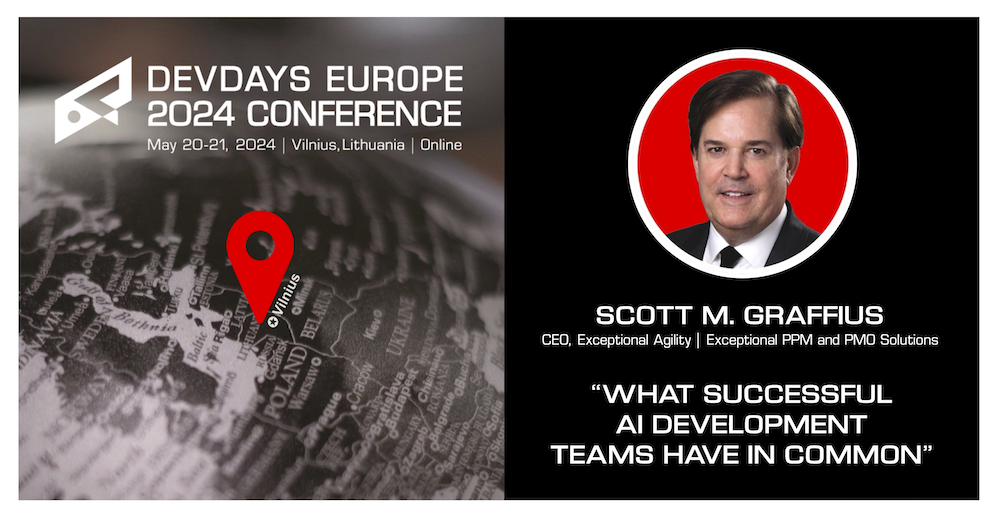

Agile Workflows

Agile leader, consultant, creator, multi-award-winning author (Agile Scrum: Your Quick Start Guide with Step-by-Step Instructions and Agile Transformation: A Brief Story of How an Entertainment Company Developed New Capabilities and Unlocked Business Agility to Thrive in an Era of Rapid Change), and public speaker Scott M. Graffius delights audiences around the world with talks and workshops on Agile, AI, Project Management, and more. He uses everyday language and vibrant custom visuals to make complex topics clear and understandable, and he provides audiences with practical information they can use. His sessions are highly rated by attendees and organizers alike.
Conference organizers, businesses, professional associations, government agencies, and universities around the world invite Scott to speak. He’s presented 89 talks and workshops at conferences and other events across 25 countries.
Scott's newest engagement will be the Vilnius, Lithuania-based DevDays Europe 2024 Conference. Informed by his work on AI projects — as well as research from DARPA, Google, IBM, IEEE, Microsoft, Nvidia, Oracle, USAII, and other organizations — he’ll present “What Successful AI Development Teams Have in Common.” Scott’s session will take place at 10:00 a.m. Eastern European Time on Tuesday, May 21, 2024.
About the DevDays Europe 2024 Conference
DevDays Europe brings together internationally recognized speakers and developers to encourage excellence and innovation in the software development community. The conference will cover emerging technologies and best practices in the software development industry — regardless of technological platform or language — without commercial hype. It will run from May 20-21, 23-24. Sessions will take place in the dynamic ambiance of movie theater halls at the Multikino Ozas, Vilnius, Lithuania. To learn more, visit the conference website at https://devdays.lt.



About Scott M. Graffius

Scott M. Graffius, PMP, SA, CSP-SM, CSP-PO, CSM, CSPO, SFE, ITIL, LSSGB is an agile project management practitioner, consultant, multi-award-winning author, and international keynote speaker. He is the Founder of Exceptional PPM and PMO Solutions™ and subsidiary Exceptional Agility™. He has generated over $1.9 billion of business value in aggregate for Global Fortune 500 businesses and other organizations he has served. Graffius and content from his books (Agile Scrum: Your Quick Start Guide with Step-by-Step Instructions and Agile Transformation: A Brief Story of How an Entertainment Company Developed New Capabilities and Unlocked Business Agility to Thrive in an Era of Rapid Change), talks, workshops, and more have been featured and used by businesses, professional associations, governments, and universities. Examples include Microsoft, Oracle, Broadcom, Cisco, Gartner, Project Management Institute, IEEE, Qantas, National Academy of Sciences, United States Department of Energy, New Zealand Ministry of Education, Yale University, Tufts University, and others. He has delighted audiences with dynamic and engaging talks and workshops on agile, project management, and technology leadership at 89 conferences and other events across 25 countries.
Connect with Scott on:


About Agile Scrum: Your Quick Start Guide with Step-by-Step Instructions

Shifting customer needs are common in today's marketplace. Businesses must be adaptive and responsive to change while delivering an exceptional customer experience to be competitive.
There are a variety of frameworks supporting the development of products and services, and most approaches fall into one of two broad categories: traditional or agile. Traditional practices such as waterfall engage sequential development, while agile involves iterative and incremental deliverables. Organizations are increasingly embracing agile to manage projects, and best meet their business needs of rapid response to change, fast delivery speed, and more.
With clear and easy to follow step-by-step instructions, Scott M. Graffius's award-winning Agile Scrum: Your Quick Start Guide with Step-by-Step Instructions helps the reader:
- Implement and use the most popular agile framework―Scrum;
- Deliver products in short cycles with rapid adaptation to change, fast time-to-market, and continuous improvement; and
- Support innovation and drive competitive advantage.
Hailed by Literary Titan as “the book highlights the versatility of Scrum beautifully.”
Winner of 17 first place awards.
Agile Scrum: Your Quick Start Guide with Step-by-Step Instructions is available in paperback and ebook/Kindle worldwide. Some links by country follow.
- 🇦🇺 Australia
- 🇦🇹 Austria
- 🇧🇪 Belgium
- 🇧🇷 Brazil
- 🇨🇦 Canada
- 🇨🇿 Czech Republic
- 🇩🇰 Denmark
- 🇫🇮 Finland
- 🇫🇷 France
- 🇩🇪 Germany
- 🇬🇷 Greece
- 🇭🇺 Hungary
- 🇮🇳 India
- 🇮🇪 Ireland
- 🇮🇱 Israel
- 🇮🇹 Italy
- 🇯🇵 Japan
- 🇱🇺 Luxembourg
- 🇲🇽 Mexico
- 🇳🇱 Netherlands
- 🇳🇿 New Zealand
- 🇳🇴 Norway
- 🇪🇸 Spain
- 🇸🇪 Sweden
- 🇨🇭 Switzerland
- 🇦🇪 UAE
- 🇬🇧 United Kingdom
- 🇺🇸 United States
- 🌏 More countries

About Agile Transformation: A Brief Story of How an Entertainment Company Developed New Capabilities and Unlocked Business Agility to Thrive in an Era of Rapid Change

Thriving in today's marketplace frequently depends on making a transformation to become more agile. Those successful in the transition enjoy faster delivery speed and ROI, higher satisfaction, continuous improvement, and additional benefits.
Based on actual events, Agile Transformation: A Brief Story of How an Entertainment Company Developed New Capabilities and Unlocked Business Agility to Thrive in an Era of Rapid Change provides a quick (60-90 minute) read about a successful agile transformation at a multinational entertainment and media company, told from the author's perspective as an agile coach.
The award-winning book by Scott M. Graffius is available in paperback and ebook/Kindle worldwide. Some links by country follow.
- 🇦🇺 Australia
- 🇦🇹 Austria
- 🇧🇷 Brazil
- 🇨🇦 Canada
- 🇨🇿 Czech Republic
- 🇩🇰 Denmark
- 🇫🇮 Finland
- 🇫🇷 France
- 🇩🇪 Germany
- 🇬🇷 Greece
- 🇮🇳 India
- 🇮🇪 Ireland
- 🇯🇵 Japan
- 🇱🇺 Luxembourg
- 🇲🇽 Mexico
- 🇳🇱 Netherlands
- 🇳🇿 New Zealand
- 🇪🇸 Spain
- 🇸🇪 Sweden
- 🇨🇭 Switzerland
- 🇦🇪 United Arab Emirates
- 🇬🇧 United Kingdom
- 🇺🇸 United States
- 🌏 More countries

Let's Connect

Connect with AgileScrumGuide.com on:
And connect with agile project management practitioner, consultant, award-winning author, and international speaker Scott M. Graffius on:

© Copyright 2024 Scott M. Graffius, AgileScrumGuide.com. All rights reserved. This material may not be published, broadcast, rewritten or redistributed without the express written permission of Scott M. Graffius/AgileScrumGuide.com.

Leverage the Phases of Team Development (Forming, Storming, Norming, Performing, and Adjourning) to Help Your Teams Succeed: 2025 Update
10 January 2025
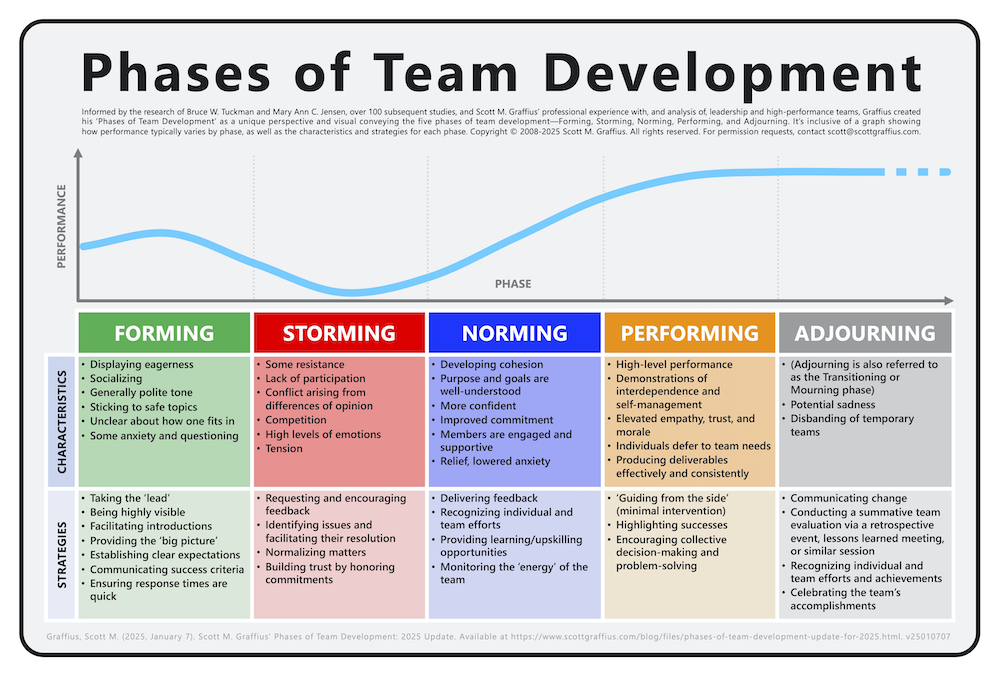
High Resolution Files of Visual: See Permission Request Information section


Introduction
Informed by the research of Bruce W. Tuckman and Mary Ann C. Jensen, over 100 subsequent studies, and Scott M. Graffius’ first-hand professional experience with, and analysis of, team leadership and performance, Graffius created his 'Phases of Team Development' as a unique perspective and visual conveying the five phases of team development—Forming, Storming, Norming, Performing, and Adjourning—inclusive of a graph showing how performance varies by phase, as well as the characteristics and strategies for each phase.
Graffius initially developed his unique material in 2008, and he periodically updates it. This article presents the refreshed 2025 edition.
Project Managers, Scrum Masters, Agile Coaches, DevOps Leads, and other leaders can apply these insights to overcome team challenges, fostering happiness, productivity, and success.
This article has “team development” in the title. Alternative terms that may be interchangeable in the context of this discussion include group development, group dynamics, high-performance teaming, strategic team building, team agility, team building, team coaching, team collaboration, team dynamics, team leadership, team optimization, team performance, team tradecraft, teamcraft, teamwork, and teamwork tradecraft.


Five Phases of Team Development
1. Forming
Characteristics of the Forming phase include displaying eagerness, socializing, a generally polite tone, sticking to safe topics, being unclear about how one fits in, and some anxiety and questioning.
Strategies for Forming include taking the ‘lead,’ being highly visible, facilitating introductions, providing the ‘big picture,’ establishing clear expectations, communicating success criteria, and ensuring response times are quick.
2. Storming
Traits of the Storming phase include some resistance, lack of participation, conflict arising from differences of opinion, competition, high levels of emotions, and tension.
Strategies for Storming include requesting and encouraging feedback, identifying issues and facilitating their resolution, normalizing matters, and building trust by honoring commitments.
3. Norming
Features of the Norming phase include developing cohesion; purpose and goals are well-understood; more confident; improved commitment; members are engaged and supportive; and relief, lowered anxiety.
Strategies for Norming include delivering feedback, recognizing individual and team efforts, providing learning/upskilling opportunities, and monitoring the ‘energy’ of the team.
4. Performing
Characteristics of the Performing phase include high-level performance; demonstrations of interdependence and self-management; elevated empathy, trust, and morale; individuals defer to team needs; and producing deliverables effectively and consistently.
Strategies for Performing include ‘guiding from the side’ (minimal intervention), highlighting successes, and encouraging collective decision-making and problem-solving.
5. Adjourning
Typical traits of the Adjourning phase (also referred to as the Transitioning or Mourning phase) include potential sadness and the disbanding of temporary teams.
Strategies for Adjourning include communicating change; conducting a summative team evaluation via a retrospective event, lessons learned meeting, or similar session; recognizing individual and team efforts and achievements; and celebrating the team's accomplishments.


Conclusion
These insights provide a practical framework to navigate the complexities of group dynamics. Whether you’re a Project Manager guiding a cross-functional team, a Scrum Master fostering agility, a DevOps Lead bridging development and operations, or another leader, understanding and leveraging the phases of team development can transform challenges into opportunities. And they’ll advance the teams’—and your own—happiness, productivity, and success.
Organizations around the world engage Graffius to deliver compelling talks and workshops. To date, he's presented sessions at 91 conferences and other events across 25 countries:
- Armenia,
- Australia,
- Brazil,
- Canada,
- Czech Republic,
- Finland,
- France,
- Germany,
- Greece,
- Hong Kong,
- Hungary,
- India, Ireland,
- Lithuania,
- Luxembourg,
- Nepal,
- Netherlands,
- New Zealand,
- Norway,
- Romania,
- Sweden,
- Switzerland,
- United Arab Emirates,
- United Kingdom,
- and the United States.
Scott M. Graffius’ 'Phases of Team Development' intellectual property is central and key to many of those sessions.
Graffius is a global expert on high-performance teams and he delivers engaging talks and workshops that bring teamwork tradecraft to life. His sessions are tailored to inspire, educate, and equip audiences with actionable tools for success. Whether at global conferences or private corporate events, he provides a fresh perspective on leadership and teamwork.
For booking inquiries, complete the speaker engagement request form or email directly to explore how Graffius can help elevate your organization’s performance.
Read on for:
- Coverage of Graffius’ Research,
- Sources/References,
- About Scott M. Graffius,
- Permission Request Information,
- How to Cite This Article,
- and more.


Graffius’ Research is Widely Cited, Featured, and Used
Businesses, professional associations, government agencies, universities, researchers, journalists, and others around the world have featured and used prior editions of Scott M. Graffius’ ;Phases of Team Development; material. Here are some examples:
- Adobe,
- American Management Association,
- Amsterdam Public Health Research Institute,
- Bayer,
- Boston University,
- Broadcom,
- Cisco,
- CodeMonk,
- Dagen,
- Deimos Aerospace,
- DevOps Institute,
- Erste Group Bank AG (Austria),
- FINAT,
- Ford Motor Company,
- FSU College of Medicine,
- Hasso Plattner Institute,
- IEEE,
- Innovify,
- Johns Hopkins University,
- Journal of Neurosurgery,
- LeadingEng,
- Life Sciences Trainers & Educators Network (LTEN),
- London South Bank University,
- Manufacturers Alliance,
- Mary Raum (Professor of National Security Affairs, United States Naval War College),
- Microsoft,
- New Zealand Government,
- Oracle,
- Prima Resource,
- Royal Australasian College of Physicians,
- Singapore University of Social Sciences,
- TBS Switzerland,
- Technical University of Munich,
- Torrens University (Australia),
- Tufts University,
- U.S. National Park Service,
- U.S. Tennis Association,
- UC San Diego,
- UK Sports Institute,
- University of Galway (Ireland),
- University of Graz (Austria),
- University of Waterloo,
- Victorian Institute of Technology (Australia),
- Virginia Tech,
- Warsaw University of Technology,
- Western Sydney University,
- Yale University,
- and many others.
These examples demonstrate the widespread recognition and application of Scott M. Graffius' 'Phases of Team Development' work across diverse sectors and entities around the world.


References/Sources
Select (partial) bibliography:
- Activision Blizzard (2022, September 9). Tackling the Talent Shortage: Identifying the Skills Critical for Game Development. Available at: https://www.activisionblizzard.com/content/atvi/activisionblizzard/ab-touchui/ab/web/en/newsroom/2022/09/tackling-the-talent-shortage.html.
- Alfateh, Maryam Ali Abu; Messaadia, Mourad; and Ali, Mazen (2023, September). Exploring the Dynamics of Team Formation in Human-Artificial Intelligence Collaboration. In 2023 International Conference on Decision Aid Sciences and Applications (DASA), pp. 384-388, DOI: 10.1109/DASA59624.2023.10286788.
- Alford, J. (2019, April 11). Our Co-Production Journey: From Sandpits to Bird Boxes. London, United Kingdom: Imperial College London.
- Ali, A. J., Fuenzalida, J., Gómez, M., & Williams, M. J. (2021, June). Four Lenses on People Management in the Public Sector: An Evidence Review and Synthesis. Oxford Review of Economic Policy, 37 (2): 335-366.
- Amsterdam Public Health Research Institute (2021). APH Quality Handbook. Amsterdam: Amsterdam Public Health Research Institute.
- Bandai Namco (n.d.). Teamwork Makes the Dream Work. Available at: https://bandainamcomobile.com/news/power-up-your-teamwork-how-bandai-namco-mobile-builds-stronger-teams.
- Bellet, C., De Neve, J., & Ward, G. (2019 October 14). Does Employee Happiness Have an Impact on Productivity? Saïd Business School WP 2019-13. Oxford, UK: Oxford University.
- Bennett, M., Gadlin, H., & Marchand, C. (2018). Collaboration Team Science: Field Guide. Rockville, MD: National Institutes of Health.
- Berlin School of Business and Innovation (2022, September 22). How Do Technical Abilities Combined with Leadership Skills Fuel Career Growth? Available at: https://www.berlinsbi.com/blog/career-advice/how-do-technical-abilities-combined-with-leadership-skills-fuel-career-growth.
- Brief, A. P. & Weiss, H. M. (2022, February). Organizational Behavior: Affect in the Workplace. Annual Review of Psychology, 53 (1): 279-307.
- Buckinghamshire New University (2024). Strategic Leadership. International Master of Business Administration Programme.
- Caredda, Sergio (2020, January 20) (updated 2021, December 10). Models: Tuckman’s Stages of Team Development. Available at: https://sergiocaredda.eu/organisation/models-tuckmans-stages-of-team-development.
- Cisco (2019). Next-Generation IT Talent Strategies: How CIOs Can Close the Skills Gap and Drive True Business Transformation. Available at: https://www.cisco.com/c/dam/global/en_uk/solutions/executive-perspectives/pdf/ITTalent.pdf.
- Constructor University (2024). Master of Science in Advanced Software Technology. Available at: https://constructor.university/sites/default/files/2024-09/AST_MSc_Handbook__2024.pdf.
- Couture, N. (2016, October 27). A Note About Teams. CIO. Boston, MA: International Data Group (IDG).
- Daly, L. (2002). Identify Your Project Management Team’s Level of Development and Facilitate It to Success. Paper presented at Project Management Institute Annual Seminars and Symposium, San Antonio, TX. Newtown Square, PA: Project Management Institute.
- Dechurch, Leslie; & Mesmer-Magnus, Jessica. (2010). The Cognitive Underpinnings of Effective Teamwork: A Meta-Analysis. The Journal of Applied Psychology, 95: 32-53.
- Defense Advanced Research Projects Agency (DARPA) (2023, February 23). Episode 65: A Sprint to Tomorrow, Powered by Teamwork [Podcast]. Available at: https://www.darpa.mil/news-events/2023-02-23a.
- Deloitte (2017). Digital Era Technology Operating Models, Volume 2. New York, NY: Deloitte Touche Tohmatsu Limited.
- DevOps Institute (2021). 2021 Upskilling Enterprise DevOps Skills Report. Boca Raton, FL: DevOps Institute.
- Dickinson, A.; & Stoneman, K. (1989). Individual Performance as a Function of Group Contingencies and Group Size. Journal of Organizational Behavior Management, 10: 131-150.
- Dolev, Niva, & Itzkovich, Yariv (2020). In the AI Era, Soft Skills are the New Hard Skills. In: Artificial Intelligence and Its Impact on Business, pp. 55-77. Charlotte, NC: Information Age Publishing.
- Dzombak, Rachel, & Palat, Jay (2021, August 30). 5 Ways to Start Growing an AI-Ready Workforce. Pittsburgh, PA: Software Engineering Institute, Carnegie Mellon University.
- Elliott, Joshua (n.d.). Artificial Social Intelligence for Successful Teams (ASIST). Arlington, VA: Defense Advanced Research Projects Agency (DARPA).
- Europass Teacher Academy (2023). Leadership and Management for School Principals. Available at: https://sgv.si/wp-content/uploads/2023/12/Porocilo-o-mobilnosti-Urska-Doblehar.pdf.
- Exceptional Agility (2023, January 1). Making Teams More Agile: Strategies and Benefits. Available at: https://exceptionalagility.com/blog/files/teams.html.
- Fédération Internationale des Fabricants et Transformateurs d'Adhésifs et Thermocollants sur Papiers et Autres Supports (FINAT) (2024, April). FINAT Committee Summit Amsterdam 2024.
- Finkelstein, S. (2017, October 29). Why Companies Should Hire Teams, Not Individuals. The Wall Street Journal. New York, NY: The Wall Street Journal.
- Forbes (2012, October 27). How the iPad Mini is Defining Tim Cook’s Apple. Forbes. New York, NY: Forbes.
- Forbes (2018, April 23). How to Fast-Track Any Team to Success. Forbes. New York, NY: Forbes.
- Gartner (2020, December 15). How to Staff Your AI Team. Available at: https://www.gartner.com/smarterwithgartner/how-to-staff-your-ai-team.
- Glover, P. (2012, March 13). Team Conflict: Why It’s a Good Thing. Fast Company. New York, NY: Mansueto Ventures.
- Gorman, Austin (2023, April 27). How to Strengthen Your Soft Skills for AI and the Future of Work. Fast Company. Available at: https://www.fastcompany.com/90887540/how-to-strengthen-your-soft-skills-for-ai-and-the-future-of-work.
- Graffius, Scott M. (2016, January 21). 2014 NSDM Publication on Leadership by National Security Affairs Professor Mary Raum Featured the 2008 Edition of Scott M. Graffius’ Work on Team Development. Available at: https://scottgraffius.com/blog/files/nsdm-leadership.html.
- Graffius, Scott M. (2016). Agile Scrum: Your Quick Start Guide with Step-by-Step Instructions. North Charleston, SC: CreateSpace.
- Graffius, Scott M. (2018, October 18). Agile Scrum Helps Innovators, Disruptors, and Entrepreneurs Develop and Deliver Products at Astounding Speed Which Drives Competitive Advantage [Presentation]. Talk delivered at Techstars Startup Week Conference. DOI: 10.13140/RG.2.2.25009.12647.
- Graffius, Scott M. (2019). Agile Transformation: A Brief Story of How an Entertainment Company Developed New Capabilities and Unlocked Business Agility to Thrive in an Era of Rapid Change. Scotts Valley, CA: CreateSpace.
- Graffius, Scott M. (2021, February 20). But First, the Team! [Presentation]. Talk delivered at the Brno, Czech Republic DevConf.CZ 2021 Conference. Digital Object Identifier (DOI): 10.13140/RG.2.2.29016.72964. DOI link: https://dx.doi.org/10.13140/RG.2.2.29016.72964.
- Graffius, Scott M. (2021, June 21). DevOps and Team Leadership [Workshop]. Session at private event in Las Vegas, NV. DOI: 10.13140/RG.2.2.15380.22401.
- Graffius, Scott M. (2021, May 13). But First, the Team! [Presentation]. Lecture delivered at DevOps Pro Europe 2021 Conference. Based and simulcast live from Vilnius, Lithuania. DOI: 10.13140/RG.2.2.30524.36481.
- Graffius, Scott M. (2021, November 10). An Error Was Introduced Into the Seventh Edition of 'A Guide to the Project Management Body of Knowledge (PMBOK).’ Los Angeles, CA: Scott M. Graffius.
- Graffius, Scott M. (2021, November 8). Bruce Tuckman’s Model (Forming, Storming, Norming, Performing, and Adjourning) is Highly Relevant and Beneficial, But It Doesn’t Please Everyone. Los Angeles, CA: Scott M. Graffius.
- Graffius, Scott M. (2021, November 8). Bruce Tuckman’s Model (Forming, Storming, Norming, Performing, and Adjourning) is Highly Relevant and Beneficial, But It Doesn’t Please Everyone. Available at: https://scottgraffius.com/blog/files/jobs.html.
- Graffius, Scott M. (2021, October 5). Navigate the Phases of Team Development with Speed and Agility for Happier and More Productive Teams [Presentation]. Talk delivered at the Institute of Electrical and Electronics Engineers IEEE Day 2021 Conference. Digital Object Identifier (DOI): 10.13140/RG.2.2.20055.19365. DOI link: https://dx.doi.org/10.13140/RG.2.2.20055.19365.
- Graffius, Scott M. (2021). Phases of Team Development. Los Angeles, CA: Scott M. Graffius. Digital Object Identifier (DOI): 10.13140/RG.2.2.22040.42246.
- Graffius, Scott M. (2022, February 4). Team Development Tradecraft: A Source of Competitive Advantage [Workshop]. Session at private event in Adelaide, Australia. DOI: 10.13140/RG.2.2.14092.80002.
- Graffius, Scott M. (2022, May 13). Want Happier and More Productive DevOps Teams? [Presentation]. Talk delivered at DevOpsDays Geneva, Switzerland 2022 Conference. Digital Object Identifier (DOI): 10.13140/RG.2.2.22252.85127. DOI link: https://dx.doi.org/10.13140/RG.2.2.22252.85127.
- Graffius, Scott M. (2023, April 26). The Science of High-Performance Teams [Presentation]. Talk delivered at the DevOps Institute’s SKILup Day 2023 Conference. Digital Object Identifier (DOI): 10.13140/RG.2.2.15888.28169. DOI link: https://dx.doi.org/10.13140/RG.2.2.15888.28169.
- Graffius, Scott M. (2023, January 9). Use the Phases of Team Development (Based on Bruce W. Tuckman's Model of Forming, Storming, Norming, Performing, and Adjourning) to Help Teams Grow and Advance: 2023 Update. Available at: https://scottgraffius.com. Digital Object Identifier (DOI): 10.13140/RG.2.2.10720.35846. DOI link: https://dx.doi.org/10.13140/RG.2.2.10720.35846.
- Graffius, Scott M. (2023, July 15). Successful Video Game Development Teams Leverage an Extensive Range of Hard Skills and Soft Skills. Available at: https://scottgraffius.com/blog/files/gamedev.html. DOI: 10.13140/RG.2.2.31205.17124.
- Graffius, Scott M. (2023, June 23). What Successful AI Teams Have in Common. Talk at Conf42 Quantum Computing Conference. DOI: 10.13140/RG.2.2.29382.45120.
- Graffius, Scott M. (2023, June 29). What Successful AI Teams Have in Common [Presentation]. Talk delivered at Conf42 Quantum Computing 2023 Conference. Digital Object Identifier (DOI): 10.13140/RG.2.2.29382.45120. DOI link: https://dx.doi.org/10.13140/RG.2.2.29382.45120.
- Graffius, Scott M. (2023, May 1). Fueling the Development of Innovative and Life-Changing AI Solutions [Presentation]. Talk delivered to an audience of Technology professionals (including Data Scientists, Machine Learning Engineers, Data Engineers, AI Researchers, Project Managers, Business Analysts, UX Designers, Software Developers, Cloud Architects, Data Privacy and Security Specialists, and others involved or interested in AI) at a private event in Mountain View, California, United States. Digital Object Identifier (DOI): 10.13140/RG.2.2.27956.73601. DOI link: https://dx.doi.org/10.13140/RG.2.2.27956.73601.
- Graffius, Scott M. (2023, October 13). The Science of High-Performance Game Development Teams [Presentation]. Talk delivered at the W Love Games International Video Game Development Conference 2023 - Helsinki, Finland. Digital Object Identifier (DOI): 10.13140/RG.2.2.28602.16326. DOI link: https://dx.doi.org/10.13140/RG.2.2.28602.16326.
- Graffius, Scott M. (2024, January 5). Scott M. Graffius’ Phases of Team Development: 2024 Update. Available at: https://scottgraffius.com/blog/files/teams-2024.html. DOI: 10.13140/RG.2.2.28629.40168.
- Graffius, Scott M. (2024, January 5). Leverage the Phases of Team Development (Forming, Storming, Norming, Performing, and Adjourning) to Help Your Teams Succeed: 2024 Update. Available at: https://agilescrumguide.com/blog/files/team-dev-2024.html.
- Graffius, Scott M. (2024, May 21). The Wild World of Team Dynamics: Forming, Storming, Norming, Performing, and Adjourning. Video. Available at: https://www.youtube.com/watch?v=vD4-XueiB1k.
- Graffius, Scott M. (2024, May 21). What Successful AI Development Teams Have in Common. Talk at DevDays Europe 2024 Conference. DOI: 10.13140/RG.2.2.24313.07529.
- Graffius, Scott M. (2024, May 3). Leverage Agile and AI to Innovate at the Speed of Light. Talk at private event in Dubai, UAE. DOI: 10.13140/RG.2.2.30790.48960.
- Graffius, Scott M. (2024, November 18). Side-by-Side Comparison of Retrospectives and Hot Washes. Available at: https://scottgraffius.com/blog/files/retrospectives-and-hot-washes.html.
- Graffius, Scott M. (2025, January 6). Dive into the 5 Phases of Team Development. Post with video on X at https://x.com/ScottGraffius/status/1876261289946968111.
- Himmelstein, D. (2018, January 26). Team Cycles and Culture Development. San Jose, CA: Acer, Inc.
- Humphrey, W. S., Chick, T. A., Nichols, W., and Pomeroy-Huff, M. (2010). Software Engineering Institute’s Team Software Process Body of Knowledge. Pittsburgh, PA: Carnegie Mellon University.
- Infinity Ward (n.d.). Infinity Ward. Available at: https://www.infinityward.com.
- International Game Developers Association (IGDA) (n.d.). IGDA Foundation. Available at: https://igda.org/igda-foundation/.
- Japan Backlog User Group (JBUG) ( ジェイバグ ) (2024, March 26). Team Building. Available at: https://speakerdeck.com/makky_tyuyan/number-jbugzha-huang-puroziekutotemapakudetimubirudeinguwoxue-bou.
- Jovanovic, M., Mesquida, A., Radaković, N., & Mas, A. (2016). Agile Retrospective Games for Different Team Development Phases. Journal of Universal Computer Science, 22: 1489-1508.
- KPMG (2017). The Digital Fund, Season 2. Amstelveen, Netherlands: KPMG International.
- Lassiter, Cathy J.; Fisher, Douglas; Osborn Faddis, Toni; and Frey, Nancy (2024). How Teams Work: A Playbook for Distributing Leadership. Thousand Oaks, California: Corwin.
- Leswing, Kif (2023, June 5). Apple’s Practical Approach to A.I.: No Bragging, Just Features. CNBC. Available at: https://www.cnbc.com/2023/06/05/apple-practical-approach-to-ai-no-bragging-just-features.html.
- Life Sciences Trainers and Educators Network (LTEN) (2022). Leveraging a Cross-Functional Training Task Force to Create Training that Doesn’t Suck. LTEN 2022 Conference.
- Luckner, M. (2020, November 18). Data Science Workshop (Version 1.1). Warsaw, Poland: Warsaw University of Technology.
- Madden, D. (2019, May 19). The Four Stages of Building a Great Team – and the One Where Things Usually Go Wrong. Inc. Magazine. New York, NY: Inc. Magazine.
- Makar, A. (2011, July 13). Lessons Learned in Norming and Performing Team Development Phases. Louisville, KY: Tech Republic.
- Manufacturers’ Alliance (n.d.). How to Create Genuine Trust in a Team. Available at: https://www.manufacturersalliance.co.uk/how-to-create-genuine-trust-in-a-team/.
- Martinuzzi, B. (2012, June 8). Six Tips Guaranteed to Reduce Workplace Frustrations. New York, NY: American Express Company.
- Massachusetts Institute of Technology (MIT) (2021, January). Cognitive Science as a New People Science for the Future of Work. Available at: https://workofthefuture.mit.edu/wp-content/uploads/2021/01/2021-Research-Brief-Polli-Kassir-Dolphin-Baker-Gabrieli.pdf.
- McKinsey & Company (2024, November 18). Making Teamwork a Science. Available at: https://www.mckinsey.com/featured-insights/people-in-progress/making-teamwork-a-science.
- Microsoft (2019, June 15). Is the Latest Technology the Key to Your Team’s Success, or is There Something Else? Microsoft Developer Support. Accessed at: https://devblogs.microsoft.com/premier-developer/is-the-latest-technology-the-key-to-your-teams-success-or-is-there-something-else. Redmond, WA: Microsoft.
- Mocko, G., & Linnerud, B. (2016). Measuring the Effects of Goal Alignment on Innovative Engineering Design Projects. International Journal of Engineering Education, 32: 55-63.
- Muhlestein, W. E., Chang, K. W. C., Justice, D., Johnson, S., Brown, S., & Popadich, M. (2023). Developing interdisciplinary research teams in neurosurgery: key elements to success in brachial plexus and peripheral nerve surgery. Journal of Neurosurgery, 139 (6), 1552-1559. https://doi.org/10.3171/2023.4.JNS222254
- Naso Sano (2024, November 6). Strategies for Medical Team Success. Video. Available at: https://www.youtube.com/watch?v=flXB1__Svkc.
- Negrón, A.P.P., Carranza, D.B., Muñoz, M. (2023). Video Game Development Process for Soft Skills Analysis. In: Mejia, J., Muñoz, M., Rocha, Á., Hernández-Nava, V. (eds), New Perspectives in Software Engineering. Proceedings of the 11th International Conference on Software Process Improvement (CIMPS 2022). Lecture Notes in Networks and Systems, vol. 576. New York, NY: Springer.
- Northeast Sustainable Energy Association (NESEA) (2022, March 1). Why Do Startups Innovate Better than Design Firms, and What Can We Learn from Them? Available at: https://dev6.nesea.org/sites/default/files/session-docs/bos22-302_why_do_startups_innovate_better.pdf.
- Project Management Institute - Luxembourg Chapter (2021, June). The Importance of Trust. Available at: https://www.pmi.org/chapters/luxembourg/stay-current/newsletter/the-importance-of-trust.
- Raum, Mary (2014, April 10). Leader Theory Explanations and Original Texts. NDSM. Available at: https://www.academia.edu/7044824/Leader_Theory_Explanations_and_Original_Texts.
- Riggs, A. (2020, October 15). Why I Start All My Video Meetings with Collaborative Games (Spoiler: It’s Not Boredom). Amsterdam, the Netherlands: The Next Web (TNW).
- Romanelli, M. (2019, September 11). Teamwork Accelerated. PM Times. Newmarket, Ontario, Canada: Macgregor Communications.
- Rowley, D., & Lange, M. (2007). Forming to Performing: The Evolution of an Agile Team. IEEE Computer Society Proceedings. Agile 2007, 1: 408-414.
- Sakpal, M. (2020, March 3. Learn How to Debunk These Five Restructuring Myths. Stamford, CT: Gartner, Inc.
- Sazali, A. R. B.; Khamarudin, F. B.; & Abdul Alahdad, S. N. B. (2022). Maximising the Zone of Proximal Development Benefits in Group Online Learning. International Journal of Academic Research in Business and Social Sciences, 12 (6): 1476-1496.
- Scaled Agile, Inc. (2023, March 14). Working Successfully in Agile with Remote Team Members. Available at: https://scaledagileframework.com/working-successfully-in-agile-with-remote-team-members/.
- Scrum Alliance (2020). Learning Objectives Examples. Denver, CO: Scrum Alliance.
- Stanford University (2019, September). Gathering Strength, Gathering Storms. Stanford, CA: Stanford University.
- Steiner, Ivan D. (1972). Group Process and Productivity. New York, New York: Academic Press.
- Stern, S. (2018, September 26). Is Your Team Working the Rory Underwood Way? Financial Times. London, United Kingdom: The Financial Times, a Nikkei Company.
- Tamiru, Natasha (2023, June). Team Dynamics: Five Keys to Building Effective Teams. Google. Available at: https://www.thinkwithgoogle.com/intl/en-emea/consumer-insights/consumer-trends/five-dynamics-effective-team.
- Tannenbaum, Robert, & Schmidt, Warren H. (1958). How to Choose a Leadership Pattern. Harvard Business Review, 36: 95- 101.
- Telford, R. (2013, June 4). This is Where It Gets Interesting. Armonk, NY: International Business Machines (IBM) Corporation.
- The ATACC Group (TAG) (2024). Experience Learning. Talk by emergency response physicians Dr. Mark Forrest and Dr. Halden Hutchinson-Bazely for TBS 24 Switzerland Conference. Available at: https://scanfoam.org/experience-learning-atacc/.
- Thier, Jane (2021, December 8). 'Form, Storm, Norm, Perform': Twitter’s New CEO Faces a Critical Few Months as He Seeks to Differentiate Himself from Jack Dorsey, Leadership Experts Say. Fortune. Available at: https://fortune.com/2021/12/08/form-storm-norm-perform-twitters-new-ceo-faces-a-critical-few-months-as-he-seeks-to-differentiate-himself-from-jack-dorsey-leadership-experts-say/.
- Tuckman, B. W. (1965). Developmental Sequence in Small Groups. Psychological Bulletin, 63: 384-399.
- Tuckman, B. W., & Jensen, M. A. C. (1977). Stages of Small-Group Development Revisited. Group and Organizational Studies, 2 (4): 419-427.
- United States Army (2015). Innovative Learning: A Key to National Security. Washington, DC: United States Army.
- United States General Services Administration, Office of the CTO (2021). GSA Tech Guides: Establishing an Agile Team Working Agreement. Washington, D.C.: United States General Services Administration.
- United States National Park Service (NPS) (2022, Spring). NPS Aviation Safety.
- United States Tennis Association (2024, April 8). Compete Like a Champion. Podcast. Available at: https://podcasts.apple.com/us/podcast/compete-like-a-champion/id1450860560?i=1000651761048.
- University of Waterloo (2021). SE Capstone Design Project Handbook. Edited by Derek Rayside. Waterloo, Ontario, Canada: University of Waterloo.
- Veleučilište u Rijeci (2024). Razvoj Poslovnih Ideja. Available at: https://www.veleri.hr/sites/default/files/2024-12/RAZVOJ_POSLOVNIH_IDEJA_-_Udzbenik_FINALNO_v2.pdf.
- Virginia Tech (2020, October 9). Turning to Tuckman: How to Leave a Team. Available at: https://spia.vt.edu/leadership-development/vmf-program/latest-posts/turning-to-tuckman--how-to-leave-a-team.html.
- Wheelan, S. A. (2009). Group Size, Group Development, and Group Productivity. Small-Group Research, 40 (2): 247-262.
- Yale University (2021, October 14). The Poorvu Center for Teaching and Learning Partners with the School of Engineering & Applied Science (SEAS). Available at: https://poorvucenter.yale.edu/news/poorvu-center-partners-seas-enhance-diversity-equity-inclusion-and-belonging.


Graffius, Scott M. (2025, January 10). Leverage the Phases of Team Development (Forming, Storming, Norming, Performing, and Adjourning) to Help Your Teams Succeed: 2025 Update. Available at: https://agilescrumguide.com/blog/files/teamwork-2025.html.


Permission Request Information
This work is copyright © Scott M. Graffius. All rights reserved.
To request permission to use Graffius' 'Phases of Team Development' visual shown at the top of this article, email Scott M. Graffius. If your request is approved, Graffius will give you an authorization/license and, if applicable, high-resolution files (JPG and PNG) of the visual.

About Scott M. Graffius

Scott M. Graffius is a high impact and globally recognized AI, advanced technology, agile, and project management researcher, thought leader, author, and public speaker.
Graffius has generated more than USD $1.9 billion in business value for organizations served, including Fortune 500 companies. Businesses and industries range from technology (including R&D and AI) to entertainment, financial services, and healthcare, government, social media, and more.
Graffius leads the professional services firm Exceptional PPM and PMO Solutions, along with its subsidiary Exceptional Agility. These consultancies offer strategic and tactical advisory, training, embedded talent, and consulting services to public, private, and government sectors. They help organizations enhance their capabilities and results in agile, project management, program management, portfolio management, and PMO leadership, supporting innovation and driving competitive advantage. The consultancies confidently back services with a Delighted Client Guarantee™. Graffius is a former vice president of project management with a publicly traded provider of diverse consumer products and services over the Internet. Before that, he ran and supervised the delivery of projects and programs in public and private organizations with businesses ranging from e-commerce to advanced technology products and services, retail, manufacturing, entertainment, and more. He has experience with consumer, business, reseller, government, and international markets.
He is the author of two award-winning books.
- His first book, Agile Scrum: Your Quick Start Guide with Step-by-Step Instructions (ISBN-13: 9781533370242), received 17 awards.
- His second book is Agile Transformation: A Brief Story of How an Entertainment Company Developed New Capabilities and Unlocked Business Agility to Thrive in an Era of Rapid Change (ISBN-13: 9781072447962). BookAuthority named it one of the best Scrum books of all time.
Organizations around the world invite Graffius to speak on tech (including AI), agile, project management, program management, portfolio management, and PMO leadership. He has developed and delivered unique and compelling talks and workshops. To date, Graffius has delivered 91 sessions across 25 countries. Select examples of events include Agile Trends Gov, BSides (Newcastle Upon Tyne), Conf42 Quantum Computing, DevDays Europe, DevOps Institute, DevOpsDays (Geneva), Frug’Agile, IEEE, Microsoft, Scottish Summit, Scrum Alliance RSG (Nepal), Techstars, and W Love Games International Video Game Development Conference (Helsinki), and more. With an average rating of 4.81 (on a scale of 1-5), sessions are highly valued.
For booking inquiries, complete the speaker engagement request form or email directly to explore how Graffius can help elevate your organization’s performance.
Prominent businesses, professional associations, government agencies, and universities have featured Graffius and his work including content from his books, talks, workshops, and more. Select examples include:
- Adobe,
- American Management Association,
- Amsterdam Public Health Research Institute,
- Bayer,
- BMC Software,
- Boston University,
- Broadcom,
- Cisco,
- Coburg University of Applied Sciences and Arts Germany,
- Computer Weekly,
- Constructor University Germany,
- Data Governance Success,
- Deimos Aerospace,
- DevOps Institute,
- EU's European Commission,
- Ford Motor Company,
- GoDaddy,
- Harvard Medical School,
- Hasso Plattner Institute Germany,
- IEEE,
- Innovation Project Management,
- Johns Hopkins University,
- Journal of Neurosurgery,
- Lam Research (Semiconductors),
- Leadership Worthy,
- Life Sciences Trainers and Educators Network,
- London South Bank University,
- Microsoft,
- NASSCOM,
- National Academy of Sciences,
- New Zealand Government,
- Oracle,
- Pinterest Inc.,
- Project Management Institute,
- Mary Raum (Professor of National Security Affairs, United States Naval War College),
- SANS Institute,
- SBG Neumark Germany,
- Singapore Institute of Technology,
- Torrens University Australia,
- TBS Switzerland,
- Tufts University,
- UC San Diego,
- UK Sports Institute,
- University of Galway Ireland,
- US Department of Energy,
- US National Park Service,
- US Tennis Association,
- Veleučilište u Rijeci Croatia,
- Verizon,
- Virginia Tech,
- Warsaw University of Technology,
- Wrike,
- Yale University,
- and many others.
Graffius has been actively involved with the Project Management Institute (PMI) in the development of professional standards. He was a member of the team which produced the Practice Standard for Work Breakdown Structures—Second Edition. Graffius was a contributor and reviewer of A Guide to the Project Management Body of Knowledge—Sixth Edition, The Standard for Program Management—Fourth Edition, and The Practice Standard for Project Estimating—Second Edition. He was also a subject matter expert reviewer of content for the PMI’s Congress. Beyond the PMI, Graffius also served as a member of the review team for two of the Scrum Alliance’s Global Scrum Gatherings.
Graffius has a bachelor’s degree in psychology with a focus in Human Factors. He holds nine professional certifications:
- Certified SAFe 6 Agilist (SA),
- Certified Scrum Professional - ScrumMaster (CSP-SM),
- Certified Scrum Professional - Product Owner (CSP-PO),
- Certified ScrumMaster (CSM),
- Certified Scrum Product Owner (CSPO),
- Project Management Professional (PMP),
- Lean Six Sigma Green Belt (LSSGB), and
- IT Service Management Foundation (ITIL).
He is an active member of the Scrum Alliance, the Project Management Institute (PMI), and the Institute of Electrical and Electronics Engineers (IEEE).
He divides his time between Los Angeles and Paris, France.


About Agile Scrum: Your Quick Start Guide with Step-by-Step Instructions
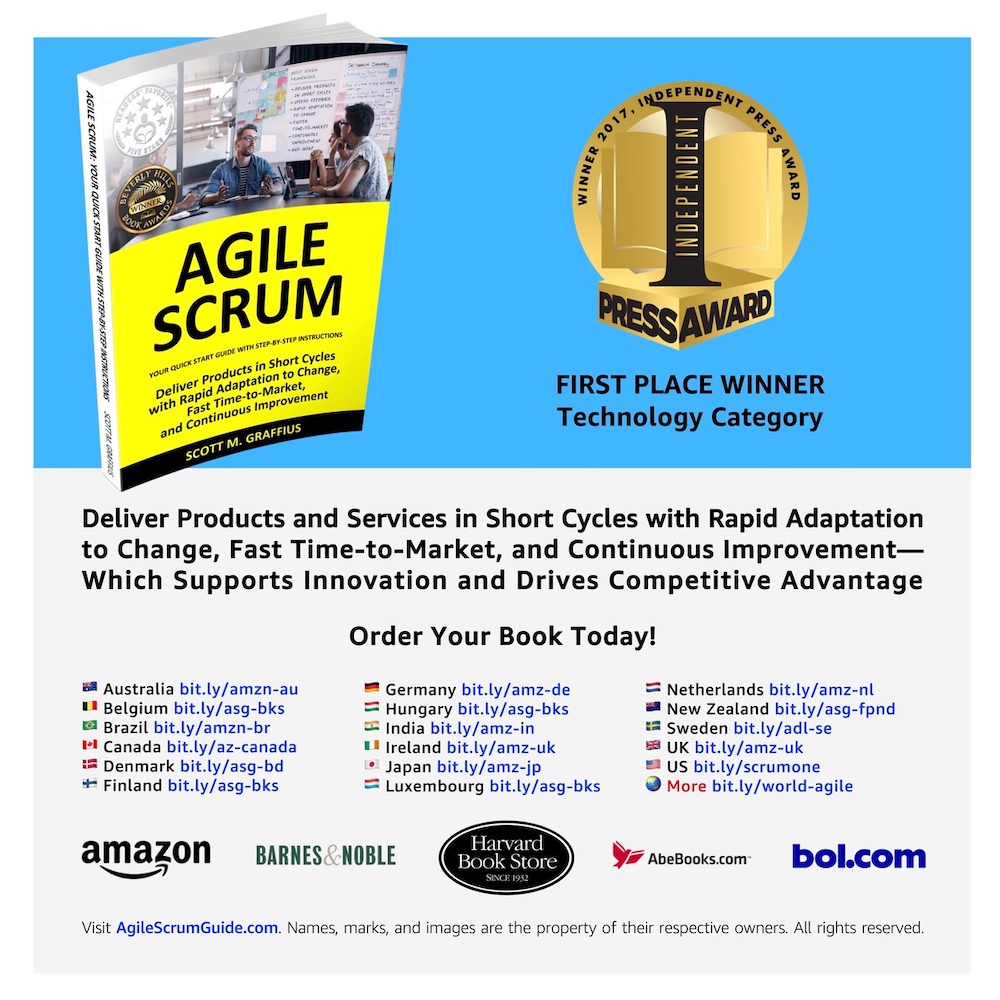
Shifting customer needs are common in today's marketplace. Businesses must be adaptive and responsive to change while delivering an exceptional customer experience to be competitive.
There are a variety of frameworks supporting the development of products and services, and most approaches fall into one of two broad categories: traditional or agile. Traditional practices such as waterfall engage sequential development, while agile involves iterative and incremental deliverables. Organizations are increasingly embracing agile to manage projects, and best meet their business needs of rapid response to change, fast delivery speed, and more.
With clear and easy to follow step-by-step instructions, Scott M. Graffius's award-winning Agile Scrum: Your Quick Start Guide with Step-by-Step Instructions helps the reader:
- Implement and use the most popular agile framework―Scrum;
- Deliver products in short cycles with rapid adaptation to change, fast time-to-market, and continuous improvement; and
- Support innovation and drive competitive advantage.
Hailed by Literary Titan as “the book highlights the versatility of Scrum beautifully.”
Winner of 17 first place awards.
Agile Scrum: Your Quick Start Guide with Step-by-Step Instructions is available in paperback and ebook/Kindle worldwide. Some links by country follow.
- 🇦🇺 Australia
- 🇦🇹 Austria
- 🇧🇪 Belgium
- 🇧🇷 Brazil
- 🇨🇦 Canada
- 🇨🇿 Czech Republic
- 🇩🇰 Denmark
- 🇫🇮 Finland
- 🇫🇷 France
- 🇩🇪 Germany
- 🇬🇷 Greece
- 🇭🇺 Hungary
- 🇮🇳 India
- 🇮🇪 Ireland
- 🇮🇱 Israel
- 🇮🇹 Italy
- 🇯🇵 Japan
- 🇱🇺 Luxembourg
- 🇲🇽 Mexico
- 🇳🇱 Netherlands
- 🇳🇿 New Zealand
- 🇳🇴 Norway
- 🇪🇸 Spain
- 🇸🇪 Sweden
- 🇨🇭 Switzerland
- 🇦🇪 UAE
- 🇬🇧 United Kingdom
- 🇺🇸 United States
- 🌏 More countries

About Agile Transformation: A Brief Story of How an Entertainment Company Developed New Capabilities and Unlocked Business Agility to Thrive in an Era of Rapid Change

Thriving in today's marketplace frequently depends on making a transformation to become more agile. Those successful in the transition enjoy faster delivery speed and ROI, higher satisfaction, continuous improvement, and additional benefits.
Based on actual events, Agile Transformation: A Brief Story of How an Entertainment Company Developed New Capabilities and Unlocked Business Agility to Thrive in an Era of Rapid Change provides a quick (60-90 minute) read about a successful agile transformation at a multinational entertainment and media company, told from the author's perspective as an agile coach.
The award-winning book by Scott M. Graffius is available in paperback and ebook/Kindle worldwide. Some links by country follow.
- 🇦🇺 Australia
- 🇦🇹 Austria
- 🇧🇷 Brazil
- 🇨🇦 Canada
- 🇨🇿 Czech Republic
- 🇩🇰 Denmark
- 🇫🇮 Finland
- 🇫🇷 France
- 🇩🇪 Germany
- 🇬🇷 Greece
- 🇮🇳 India
- 🇮🇪 Ireland
- 🇯🇵 Japan
- 🇱🇺 Luxembourg
- 🇲🇽 Mexico
- 🇳🇱 Netherlands
- 🇳🇿 New Zealand
- 🇪🇸 Spain
- 🇸🇪 Sweden
- 🇨🇭 Switzerland
- 🇦🇪 United Arab Emirates
- 🇬🇧 United Kingdom
- 🇺🇸 United States
- 🌏 More countries


Copyright © Scott M. Graffius
Copyright © Scott M. Graffius. All rights reserved.
Content on this site—including text, images, videos, and data—may not be used for training or input into any artificial intelligence, machine learning, or automatized learning systems, or published, broadcast, rewritten, or redistributed without the express written permission of Scott M. Graffius.
